Librela™ and Solensia™ are new pharmaceuticals for osteoarthritis (OA) in dogs and cats, respectively (1,2). These drugs use monoclonal antibodies (MAB) as their mechanism of action to bind up a specific molecule involved in the pain associated with arthritis in dogs and cats.
The original research that was part of gaining FDA approval of Solensia™ and Librela™ for dogs, had pretty good rates of success in reducing pain with minimal side effects. The medication is also very convenient in that only 1 injection monthly is needed to achieve relief from the pain of osteoarthritis.
Unfortunately, as is often the case with FDA-approved drugs, the true test of the drug’s effectiveness and side effects comes when the drug becomes widely used through its availability in the marketplace. This has proven true for both Librela™ and Solensia™, where some serious side effects have been noted by several pet parents and veterinarians.
This article will help pet parents understand some of the possible risks associated with these pharmaceuticals. Further, it will suggest how a natural intervention of Lion’s Mane mushroom supplementation could be used to reverse some of the serious side effects if they occur.

Researchers created monoclonal antibodies through genetic manipulation of yeast that are specific for the molecule involved with osteoarthritic pain. The molecule that Solensia™ and Librela™ acts upon is called nerve growth factor (NGF). When NGF binds to a specific membrane receptor, pain, and impaired mobility result. The antibodies in the Solensia™ and Librela™ injections prevent nerve growth factor from binding to the receptor responsible for OA pain, therefore preventing that pain from occurring.
The monoclonal antibodies have been hailed as a breakthrough in the treatment of arthritis in dogs and cats, and a similar product has been created for people with OA. The good thing about this form of medication is that it does not pose a risk of toxicity to the liver, kidney, or heart as our current arthritis medications have that potential. Therefore these medications have the potential to help pets in pain and restore some of their mobility without the typical risk to the liver, kidney, or heart.
Pet parents have been observing that some pets who are on these MAB drugs have very serious and concerning side effects. Some dogs are experiencing neurologic problems, like being unsteady on their feet (ataxia). Other dogs have experienced seizures following the Librela™ injection. Still others have developed hypersensitivity-like reactions (anaphylaxis, pruritus, facial swelling).
Other side effects that can potentially arise from the use of these two MAB drugs for arthritis in dogs and cats are (3):
There is no published, peer-reviewed paper describing these side effects in dogs. There is one published, peer-reviewed paper detailing reported side effects observed with the use of Solensia™ in cats (4). This MAB for cats was launched several years before the launching of Librela™. This is why we have this adverse event paper for cats. Hopefully, a publication regarding the side effects in dogs will be published soon.
The side effects, specifically found in the 5 cats included in this feline medicine paper, were limited to dermatological lesions that were described as:

Adverse reactions have been observed in humans using MAB injections for osteoarthritis. People complain of hyperesthesia (increased nerve sensitivity); and paraesthesia (feels like pins and needles, skin crawling, numbness, or itching). Also, a burning sensation has been described by people taking the MAB injections. If these kinds of side effects are what some cats are also feeling following the Solensia™ injections, you can understand why they would be scratching themselves sore.
Nerve growth factor (NGF) is a very important chemical messenger in mammals, including people, and our beloved dogs and cats. NGF works in part on sensory nerves, which “sense” the pain. It has an influence, not just on the nervous system, but also on the immune system. In the nervous system, the effects of NGF influence the survival of nerves and the growth of nerves. This may be why one of the side effects noted from Librela™ are seizures and weakness.
NGF is involved in the inflammatory process and can play a role in reducing inflammation. Certain nerves that produce the neurotransmitter acetylcholine depend on NGF for survival and maintenance. This may be another reason why certain adverse symptoms have been observed with Librela™. If there is a sudden loss of NGF due to it being bound up by the antibodies of Librela™, there may be a dramatic increase in inflammation due to the loss of this neurotransmitter. This effect may also influence movement difficulty, weakness, and seizures.
Lion’s mane mushroom contains terpenes and other molecules that stimulate the production of NGF. In particular, it stimulates the production of a specific NGF found in the central nervous system called brain-derived NGF or bNGF. The possibility exists that using lion’s mane mushroom supplementation for dogs concurrently with the use of Librela™, or in the event of an adverse side effect, might reduce the development of side effects or allow the dog (or cat) to overcome those side effects.
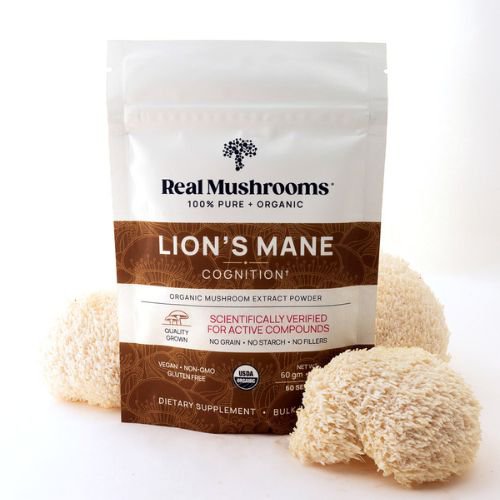
This theory has not been tested in an objective study, but does seem like a potential antidote to these adverse reactions to both Librela™ and Solensia™. In consultation with plant pharmacologist Kevin Spelman, Ph.D., who has co-authored a peer-reviewed paper on the pharmacology of lion’s mane, he expressed that using lion’s mane with its influence on NGF levels has the potential to be helpful (5). Dr. Spelman said that pet parents who want to give lion’s mane mushroom extract to their dog or cat would likely need to give relatively high doses. Also, it could take up to 4 weeks (or possibly more) to achieve any benefits. It is important to understand that at this point, the use of lion’s mane mushroom to help with the side effects of Librela™ or Solensia™ is still in the experimental phase.
Monoclonal antibodies are a new pharmaceutical technology to address different problems, such as cancer, atopy, and now, arthritis. Although the technology promises a less toxic medication in terms of adverse effects on the kidneys and liver, a whole new set of problems now exist with this newly emerged category of drug.
MAB drugs are quite specific for certain protein molecules associated with a disease condition. But, because these molecules are also involved in other bodily processes, their loss due to the monoclonal antibodies binding them up, may cause unexpected adverse effects in other systems, as we have seen with both Librela and Solensia.
Due to the effect of Librela™ and Solensia™ on reducing the serum and tissue levels of NGF, there is a lot of interest in the NGF-stimulating properties of lion’s mane mushroom for addressing this problem. In all likelihood, if lion’s mane supplementation were able to help, it would take fairly significant amounts used over a fairly prolonged period, possibly on the order of 1-3 months.
Pet parents need to learn that there are possible adverse side effects of these two new MABs for osteoarthritis to make an informed decision regarding the use of an MAB for their furry friend.

As the new year unfolds, many of us are focused on setting and achieving personal goals. In the quest for improved well-being, mushrooms – both culinary varieties and functional extracts – emerge as unsung heroes. Their unique properties and health benefits align seamlessly with the top five resolutions of 2024, as outlined in Forbes' "New Year’s Resolutions Statistics 2024" article.
According to the Forbes 2023 survey of 1000 Americans, the following resolutions were the top 5 most common responses:
Let's delve deeper into the science behind how mushrooms can support these aspirations.
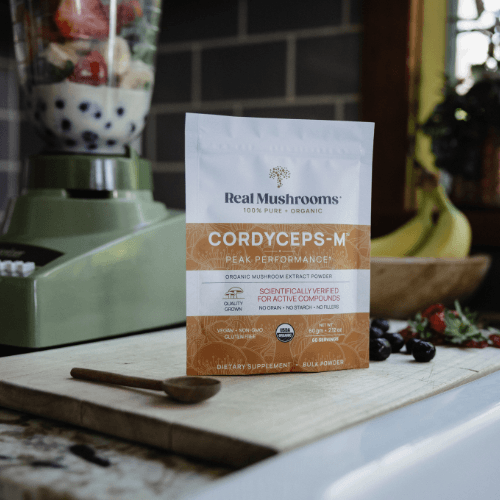
Cordyceps, a mushroom revered in traditional medicine, has garnered attention in the fitness world. Studies reveal that the cordyceps mushroom makes for an ideal pre- and post-workout supplement: It enhances aerobic capacity, delays fatigue, and improves endurance by influencing the body’s exercise utilization of oxygen and energy production [1]. This is attributed to its ability to increase adenosine triphosphate (ATP) levels, the primary energy currency of the cell, thus providing extra energy for longer, more intense workouts [2]. Moreover, as an adaptogen, a good quality cordyceps supplement can help the body manage and adapt to stress. These properties help promote better recovery post-exercise by balancing muscle inflammation and oxidative stress [3].

In the context of financial wellness, culinary mushrooms offer an economical and nutritious alternative to meat. Economically, they are less costly to produce and purchase, helping consumers save money without compromising nutritional value. Nutritionally, mushrooms are rich in proteins, vitamins (especially B vitamins), minerals (like selenium, potassium, and copper), and antioxidants [4]. This makes them a nutrient-dense food choice that provides essential nutrients without the high costs associated with meat. Incorporating mushrooms into your recipes can help stretch the food budget while contributing to a balanced diet.
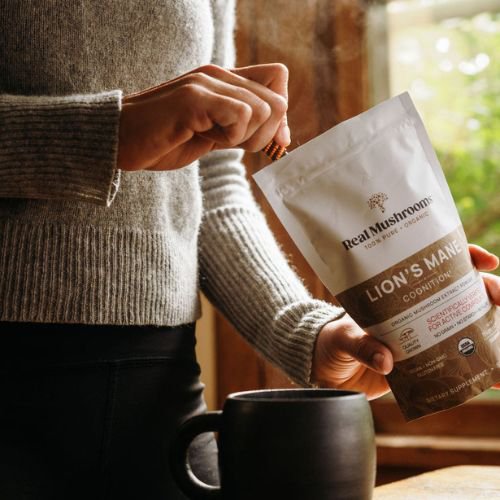
For mental health, reishi mushrooms and lion's mane are particularly noteworthy. Reishi, often termed as the "mushroom of immortality," is known for its calming properties. It contains triterpenes, which have been shown to induce sedation and decrease anxiety [7]. Studies suggest that a quality Reishi supplement can improve sleep quality by modulating the sleep-wake cycle, which is crucial for mental health and daily functioning [8].
Lion's mane has unique neuroprotective properties. It contains compounds like hericenones and erinacines that stimulate the growth of brain cells and can potentially improve cognitive function [5]. This mushroom has been linked to enhancing memory and brain function, which is crucial in the fast-paced, stress-inducing modern lifestyle [6]. A good quality lion’s mane supplement can be the key to enhancing your mental clarity.
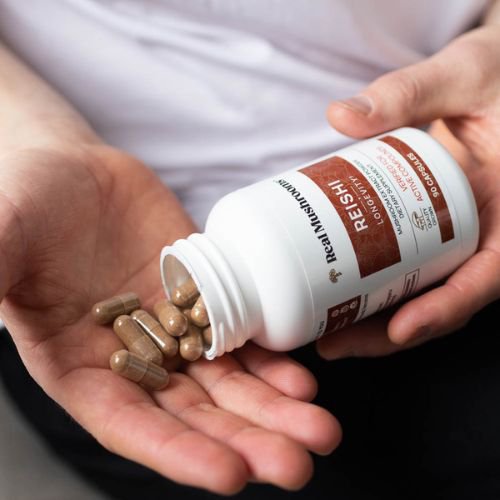
Mushrooms are a low-calorie, high-volume food, meaning they provide a lot of food with few calories, making them ideal for weight loss. Their high fiber content promotes satiety, reduces food intake, and aids in digestion. Some mushroom varieties, like Ganoderma lucidum (reishi), have been studied for their potential to manage obesity. These mushrooms contain bioactive compounds that can alter fat metabolism and regulate the expression of genes related to obesity [9].
As mentioned in section 4, Reishi can also improve sleep quality and promote a calm mood.
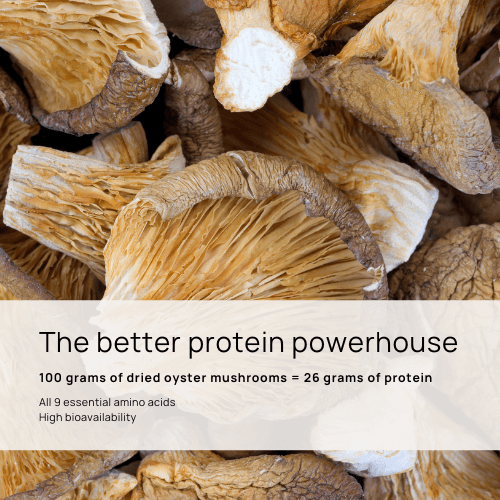
In terms of dietary improvements, mushrooms are an excellent source of several key nutrients. They are one of the few non-animal sources of vitamin D, essential for bone health and immune function [10]. They also contain B vitamins, vital for various metabolic processes, including energy production. Additionally, the antioxidants present in mushrooms, like ergothioneine and selenium, help combat oxidative stress and promote a healthy inflammation response, contributing to overall wellness and longevity [11].
In summary, mushrooms, in their various forms, stand as powerful allies in achieving the common New Year’s resolutions of 2024. They are not just a means to an end but a sustainable, health-promoting choice that benefits both personal well-being and financial health. Whether you’re looking to boost your fitness regime, manage finances wisely, support mental health, lose weight, or improve your diet, mushrooms offer a versatile and effective solution for your journey toward personal growth and wellness.

Trouble staying focused and a bit of brain fog is something we all experience at some point. Thankfully, this downtrend in concentration, no matter the cause, need not be a permanent fixture in our lives.
There are organic supplements you can take to improve cognitive function and clear that mental haze naturally.
Today we review some of the best supplements for focus and concentration and highlight trusted brands in the space.
All the products we highlight ensure high efficacy because they use certified real mushroom extracts and other exceptional natural ingredients known to have numerous benefits for brain health.
Other things we considered while compiling this list are that:
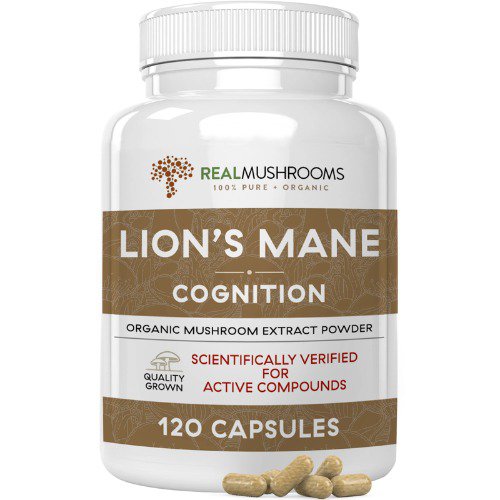
This is a potent supplement specially designed to deliver lion’s mane mushroom’s (Hericium erinaceus) natural goodness to support your brain health and cognitive function.
Lion’s mane mushroom is full of essential compounds, such as beta-glucans, immuno-modulating antioxidants, and neuroprotective phytonutrients—all essential for maintaining your brain health.
This is backed up by research showing that supplementation with lion’s mane mushroom and its extracts help promote Nerve Growth Factor (NGF) synthesis in nerve cells (1).
In adults with minor memory problems associated with aging, a study found that lion’s mane extract significantly improved brain function compared to participants who did not take the mushroom or its extracts (2).
However, to reap lion’s mane mushroom’s health-supporting benefits, you need the best quality lion’s mane extract. This is where Real Mushrooms’ Organic Lion's Mane Extract Capsules comes in. With:
It doesn’t get much better. But don’t take it from us.
“... From someone who doesn’t really expect much in supplements, I have to confess these were a huge surprise … I will be a fan of quality mushroom products for life.” - Romibee | ★★★★★
Buy Organic Lion’s Mane Extract Capsules
Related: Find the Best Lion’s Mane Supplement: The 4-Point Buying Guide
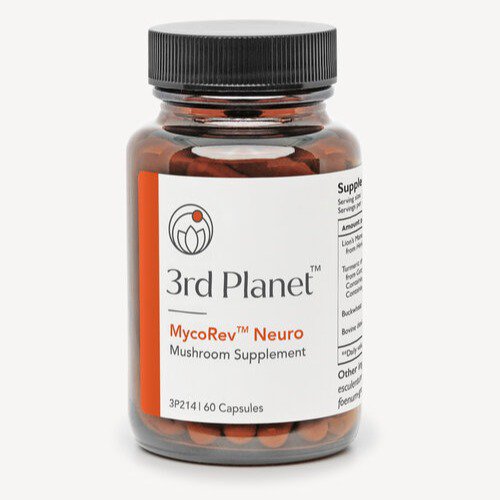
MycoRev™ Neuro consists of a complex combination of high-quality extracts to boost brain function, including lion’s mane, turmeric rhizome, buckwheat leaf, and freeze-dried bovine brain.
Each ingredient was specially selected for its synergistic neurological health-supporting benefits. But for clarity, let’s briefly examine the specific benefits these ingredients bring to the table.
CurQfen® is enriched with soluble fenugreek seed fiber to improve its bioavailability. In turn, it's able to better supply free curcuminoids to your blood plasma and improve the blood-to-brain barrier permeability, improving cognitive functions (4).
This is supported by research and clinical trials, which have confirmed the mushroom's health-supporting qualities, especially in improving cognitive function, focus, and concentration (3).
Note: MycoRev™ Neuro is made from 100% real lion’s mane mushroom (from the fruiting body) and herbs. No fillers. No binders. No additives.
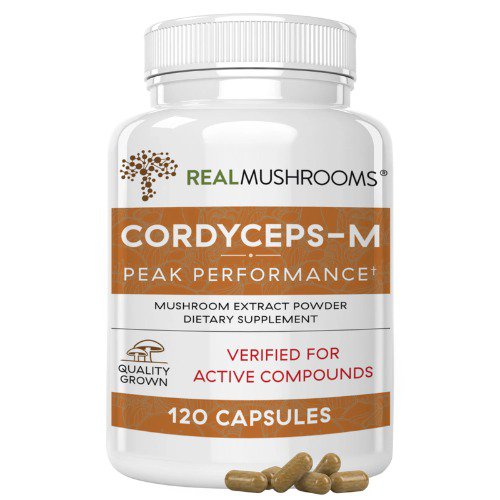
Cordyceps is yet another supplement from Real Mushrooms that’s specially formulated to deliver the goodness of real organic cordyceps.
Cordyceps mushrooms contain several beneficial bioactive compounds that provide a range of health-supporting benefits, most notably improving focus and concentration.
Cordyceps mushrooms are also known for their ability to support the immune system and are considered biomolecular immunomodulators. They help the body adapt better to immune threats—a key factor in supporting respiratory health (5).
Like all other Real Mushrooms supplements, Organic Cordyceps Extract Capsules follow strict guidelines to ensure the best quality. These include:
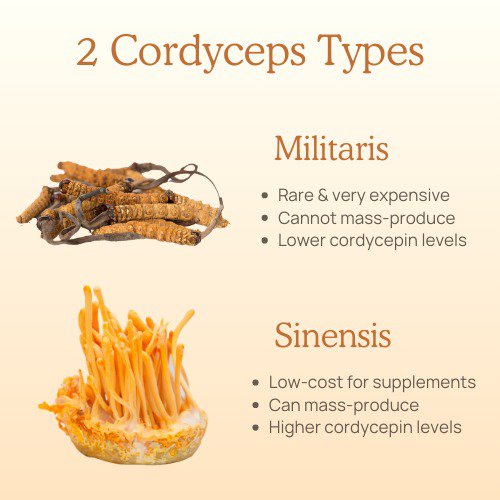
At Real Mushrooms, we use Cordyceps militaris in our supplement. While there are over 400 varieties of cordyceps mushrooms, the two most common for therapeutic use are:
Cordyceps sinensis is a health-supporting functional mushroom whose use can be traced back to traditional Chinese medicine. It’s the more commonly advertised Cordyceps mushroom in supplements.
However, it is rare, highly sought after, and very expensive. As such, some supplements that claim to contain Cordyceps sinensis also contain fillers and often use mycelium instead of the fruiting body to cut costs.
This significantly impacts efficacy and limits your ability to reap the benefits of Cordyceps mushrooms.
On the other hand, Cordyceps militaris provides all the goodness of sinensis (and more) but at a fraction of the cost. Additionally, Cordyceps militaris has been shown to contain up to 90 times more cordycepin than the sinensis variety (6).
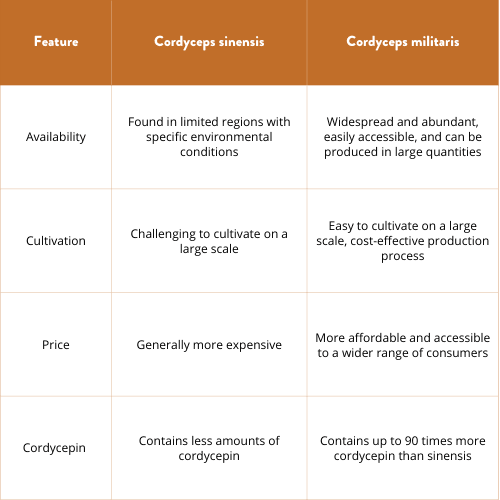
Expert Tip: The Cordyceps militaris produced in North America is mainly myceliated grain. Pure mushroom extract almost exclusively comes from Asia, with China accounting for over 90% of the global supply. This is why we source our mushrooms from Asia.
Related: Cordyceps Sinensis vs. Militaris: What’s the Best Cordyceps Supplement?

Neurofuel™ contains an advanced blend of 100% natural focus supplements designed to enhance focus and improve memory.
It works as fuel for your neurotransmitters by supporting better signaling between your brain cells. It also provides your body with the ingredients it needs to power Long Term Potentiation (LTP) processes.
When LTP is enhanced, you experience increased alertness, curiosity, and creativity.
As such, Neurofuel™ users often report:
“Of the countless nootropics I’ve tried over the years, I always come back to Neurofuel™. I have my best, most productive work days when I start my day with this!” - Kimi | ★★★★★
The key ingredients in Neurofuel™ that give it its cognitive and brain health-supporting qualities include:
Buy Natural Stacks’ Neurofuel™
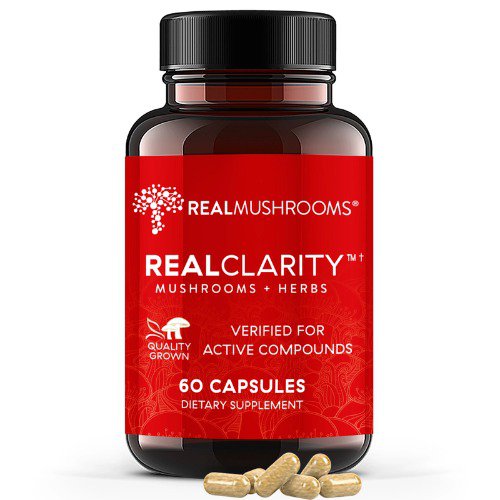
Real Clarity is a powerhouse supplement for improving focus, concentration, and overall brain function by leveraging the goodness of real organic mushrooms and herbs.
Real Clarity can achieve this through a blend of four health-supporting natural ingredients, all of which are essential in promoting your brain health. These are:
For instance, Ashwagandha is known to support brain health and cognitive function, and its benefits include (12):
This is supported by findings from a study where participants who took Ashwagandha supplements noticed improvements in cognitive functions in all areas (13).
These benefits were particularly noticeable in skills relating to concentration and the capacity to focus.
Rhodiola also shows mild stimulating effects, which help improve focus.
Indeed, one study showed that participants with chronic fatigue experienced an improvement in concentration after taking Rhodiola supplements (9).
This is supported by research proving that Bacopa contains potent brain-health-supporting benefits and can even protect against Alzheimer’s disease (10).
Bacopa is also considered an adaptogen thanks to its ability to help alleviate stress and anxiety by lowering cortisol levels. This also has the benefit of helping improve your focus and concentration (11).
Related: Medicinal Mushrooms: 7 Kinds and Their Unique Health Benefits
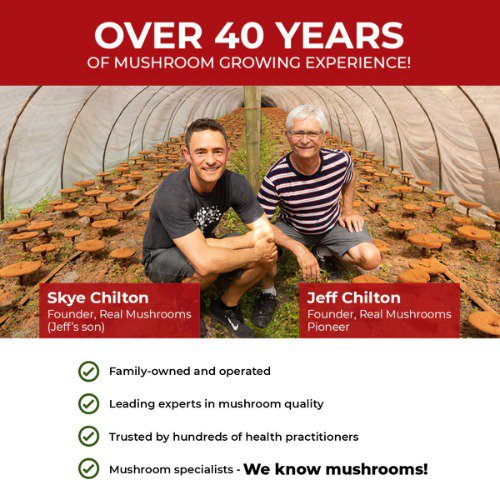
At Real Mushrooms, our goal is simple. We are driven by the desire to deliver the best functional mushroom extracts in their purest form. No filler. No additives.
To this end, we employ decades of expertise to tailor our extraction method for each mushroom we use to attain peak potency in our supplements.
Additionally, all Real Mushrooms' products are tested multiple times during production at accredited third-party facilities to ensure they are free from agricultural chemicals and other contaminants.
We also screen for heavy metals to guarantee that our products exceed the heavy metal standards set by the FDA and Health Canada.
This is how we guarantee all the therapeutic properties in our products and ensure you can enjoy high-quality supplements you’re confident in.
Visit our online store today to explore our collection of organic supplements to enhance your life. You can also check out our blog for more information about our ingredients and their numerous health-supporting benefits.

As the popularity of mushrooms as functional foods skyrockets in the world of holistic health, cat parents can't help but ask, "Can cats eat mushrooms?" As experts on the subject, let's unravel this question.
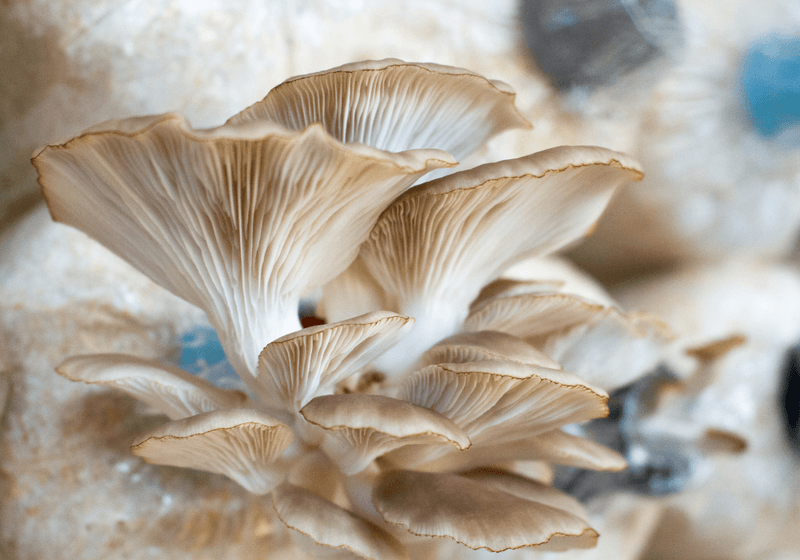
Mushrooms are complex, highly adaptive organisms with properties that can target various bodily functions. They're rich in immune-stimulating compounds that have been instrumental throughout evolution, allowing animals to fend off pathogens. When mushrooms are consumed, they trigger an "alert" in the immune system, primarily through bioactive compounds such as beta-glucans.
In other words, mushrooms can be likened to the first light of dawn that wakes up a nocturnal bird, preparing it for the day's activities. Consuming functional mushrooms such as turkey tail, reishi, lion's mane, and cordyceps sends a similar "rise and shine" command to your cat's body. The signal is not of an impending threat but rather an encouragement for alertness, thereby strengthening your feline companion's immune system.
To fully grasp whether cats can eat mushrooms, it's crucial to understand the four mushroom categories:
While some mushrooms fall into multiple categories, this article focuses on culinary (edible) mushrooms and functional (medicinal) mushrooms.

Safe, culinary mushrooms can be an excellent addition to your cat's diet.
However, it's important to steer clear of wild mushrooms because they can be toxic.
However, store-bought varieties of mushrooms, when well cooked, can be safely added to your cat’s diet. A note of caution: mushrooms should not be fed to animals uncooked and raw. They are difficult to digest when uncooked due to their high fiber content
Culinary mushrooms, like oyster, shiitake, and lion’s mane mushrooms, pack a nutritional punch. They're teeming with proteins, fiber, selenium, B vitamins, vitamins and polyunsaturated fatty acids. Plus, mushrooms can be an abundant source of vitamin D2 when exposed to UVB light. They also house unique antioxidants that help with longevity, like ergothioneine and glutathione.
To unlock these benefits for your cat, cooking them well is key. All mushrooms contain chitin, a component that can hinder digestibility but also serves as dietary fiber. Cooking mushrooms breaks down chitin, increasing the bioavailability of crucial immunomodulatory compounds like beta-glucans.
So, for the question, “Can cats eat mushrooms?” the answer is YES, with some qualifications — Cooked, store-bought culinary mushrooms can be safely added to your cat's diet. Start with small portions and always ensure they're well-cooked to enhance their digestibility.
Chopping up the mushroom into small little pieces improves their digestibility and allows them to be thoroughly cooked which will release their many bioactive compounds to benefit your cat’s health.
Some functional mushrooms can act as adaptogens when ingested. Adaptogens help the body adapt to physical and emotional stress over the long term, increasing attention, endurance, and overall body function.
Adding to the fascinating array of information on how mushrooms contribute to a cat's overall health, let's dive deeper into the beneficial effects of two mushrooms in particular: Cordyceps and Lion's Mane. Furthermore, we will explore how to identify quality mushroom supplements in the market and the best ways to introduce these supplements into your cat's diet.
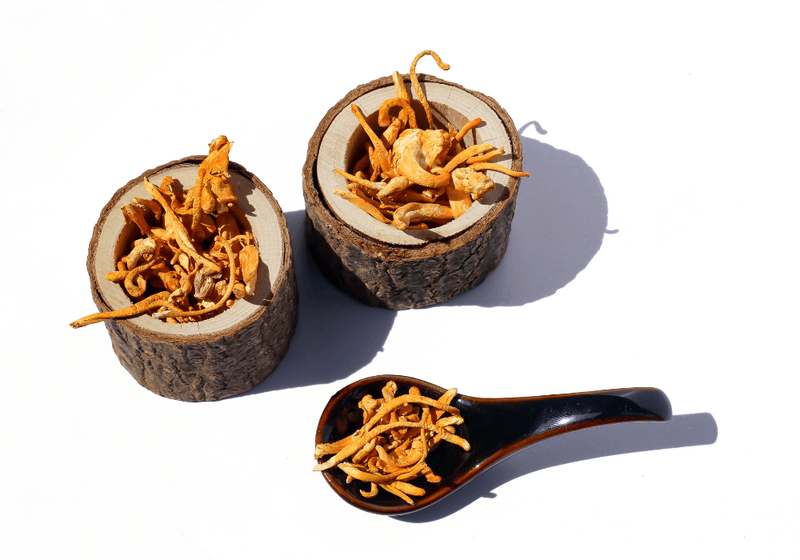
Cordyceps, a type of fungus, has remarkable benefits for cats, which should not be surprising considering that it's closely related to some of the tastiest edible mushrooms, such as truffles and morels. Its palatable taste makes it an appealing supplement for our feline friends who can be quite selective when it comes to food.
Cordyceps checks the boxes when it comes to feline health. Whether your cat is young or old, this mushroom can offer considerable support.
An alarming number of cats are prone to develop kidney disease, a condition that can sometimes be fatal. Studies in various species have shown that Cordyceps can effectively support kidney function and protect these organs from toxins, including certain antibiotics and immunosuppressive drugs (1).
This mushroom isn't just beneficial for the kidneys; it also plays a crucial role in maintaining healthy glucose levels. Just like humans, cats can develop Type 2 Diabetes, often associated with a diet rich in carbohydrates. Cordyceps helps control blood glucose levels, thanks to its special polysaccharides. It also normalizes the body's insulin production, further supporting healthy blood sugar levels (2).
Cordyceps also has an impressive effect on the respiratory system, potentially benefiting cats with bronchial asthma. It aids in maintaining healthy pulmonary function, thus promoting proper respiration (3). In addition to its lung-boosting properties, Cordyceps also offers heart health benefits (4).
Most cats would do well with an eighth of a teaspoon of pure cordyceps mushroom extract powder, mixed into their food once or twice daily.
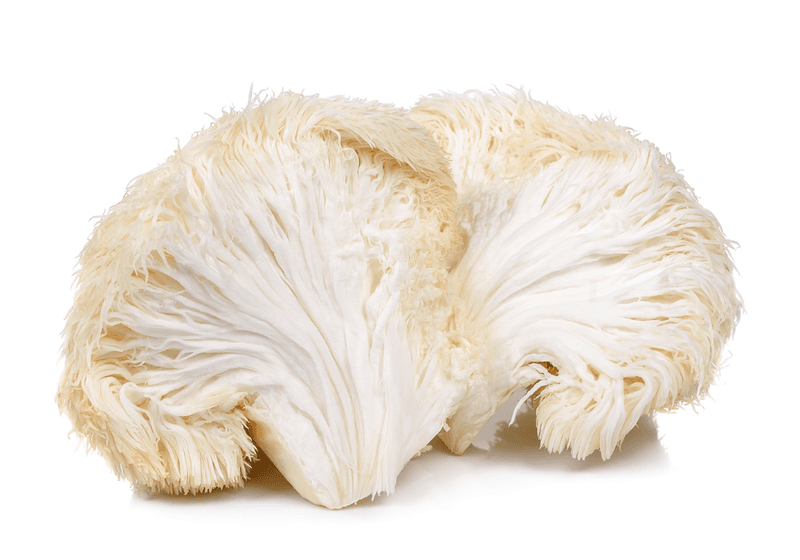
Lion’s Mane, scientifically known as Hericium erinaceus, is a mushroom that has been traditionally used in Eastern medicine for its multiple health benefits, particularly for cognitive function and gut health. With increasing interest in natural remedies for pet health, Lion’s Mane has emerged as a key supplement of interest for cat owners, offering potential benefits similar to those found in dogs.
Similar to dogs, cats are susceptible to cognitive dysfunction as they age, a condition akin to Alzheimer's in humans. An estimated 36% of cats aged between 11 and 21 show signs of dementia (5).
Human clinical trials have shown that lion’s mane mushroom can support brain function and cognition in people with mild dementia and/or memory loss (6,7). Studies on this unique functional mushroom have discovered that it supports cognition by stimulating neurogenesis, the process of forming new neurons (9, 10).
Even though rigorous clinical studies in cats have yet to be conducted, there's anecdotal evidence suggesting its positive impact.
For instance, testimonials from pet parents, as shared by Real Mushrooms’ Registered Veterinary Technician, Joni Kamlet, have reported improvements in older dogs exhibiting signs of dementia, including being more attentive, finding their way around familiar surroundings, and initiating play. Given the physiological similarities between dogs and cats, it’s plausible to speculate that lion's mane could provide similar benefits to felines, potentially improving their cognitive function and mitigating signs of feline cognitive dysfunction.
Beyond cognitive benefits, Lion’s Mane could also offer cats support for their gut health, mood, and immune system. Traditionally used in China and Japan to support gut health, nervous system weakness, and even wound healing, this mushroom has also the potential to promote a healthy inflammatory response.
Furthermore, human clinical studies have suggested lion's mane's potential role in mitigating anxiety and depression. These mood-supporting benefits could potentially be translated to cats, helping to manage behavior issues and promoting overall well-being.
Moreover, lion's mane can help regulate the immune system. Considering that cats, like all pets, can suffer from various immune-related issues, lion’s mane could provide additional support in bolstering their immune health.
To support the mind, immunity, and digestive health of your aging cat, consider mixing an eighth of a teaspoon of pure lion’s mane mushroom extract powder into their food once or twice daily.

For pet parents considering introducing lion’s mane or cordyceps supplements to their cat's diet, it's advisable to use a concentrated mushroom powder extract. Real Mushrooms offers pet products that are pre-measured for animal dosing, making them easy to administer.
Cats are notoriously picky eaters, making the introduction of new supplements a bit of a challenge. Luckily, lion's mane and cordyceps extract powders are fairly bland tasting and can easily blend into your cat's favorite dishes without causing too much of a taste disturbance.
Mushroom extract powders, such as those from Lion's Mane and Cordyceps, might be easier for cats to accept when mixed into their food. These can easily blend into your cat's favorite dishes without causing too much of a taste disturbance.
Remember that patience and persistence are key when introducing new supplements to your cat's diet. Here’s a good tip from Real Mushrooms’ Registered Veterinary Technician, Joni Kamlet about introducing new supplements to picky or cautious kitties:
It's important to note that while lion’s mane and cordyceps appear to be safe for cats, more research is needed to fully understand its impact and optimal dosing for feline health. Always consult with your veterinarian before starting any new supplementation regimen.
When it comes to choosing a mushroom supplement for your cat, it's important to prioritize quality. Look for supplements that are organic, and free from additives, pesticides, or fillers. Products that have been tested by third-party labs for purity and potency can also offer an additional layer of reassurance.
When looking to get the most medicinal value for your money, ensure you are buying a supplement that uses 100% mushrooms and not mycelium grown on grain. You can get more specific information about picking a quality mushroom product for your pet in the following articles:
As we continue to explore the potential of functional mushrooms, it's encouraging to see the possibilities they offer for enhancing our pets' health and quality of life. Whether for cognitive support, gut health, revitalization, or general wellness, they could be a valuable addition to your feline friend's wellness regimen.
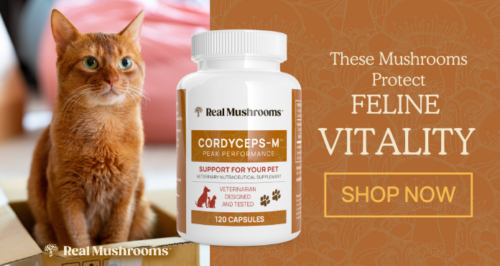
If you’ve been wanting to experiment with different mushrooms in your meals, then we present you with a simple but delicious and nutritious meat-free lion’s mane mushroom stir fry recipe.
Chef Karuna Marcotte, was delighted to bring her foraged vegetables along to help our Real Mushrooms colleague, Joni Kamlet, cook up the lion’s mane she found growing in her nearby forest.
If you don’t happen across a lion’s mane mushroom in the wild, you can find fresh ones at farmer’s markets and some specialty grocery stores.
Since lion’s mane is abundant in beneficial compounds for the brain, gut, and immune system, this protein-packed mushroom is ideal as a meat substitute on many levels.
Without further ado, we present you with this delicious lion’s mane mushroom stir fry recipe:
· 1 lb. lion’s mane mushrooms
· 2 medium-sized daikon radishes (diced)
· 3 shallots (diced)
· 4 cloves of garlic (sliced)
· 1 medium carrot (grated)
· Large bunch of kale (washed and chopped into bite-size pieces)
· Olive oil/butter
· Salt and pepper to taste

1. Brush any dirt away from the lion’s mane mushroom. (Do not immerse in water as it will absorb the liquid and alter the body of the steaks.) Slice into 1” – 1.5” steaks.
2. Heat a cast iron pan and add equal parts of olive oil and butter (enough to coat the bottom of the pan.) Add the garlic slices and the lion’s mane steaks, a single layer, depending on the size of the pan and the amount of mushroom you are cooking, you may need to fry two batches.
3. The heat should be medium to high, and the steaks will sizzle. Allow enough time on one side so the mushroom turns golden brown and a little crisp on the edges. Flip the steaks and sauté the other side. Remove from the heat and plate them.
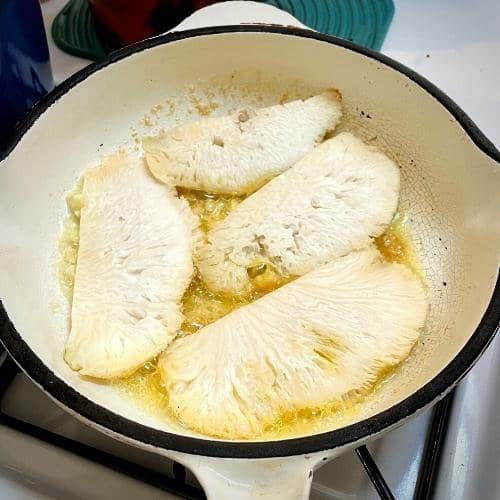
1. Heat a cast iron pan. Add enough olive oil to coat the bottom of the pan. Sprinkle a pinch of salt into the oil. Sauté the diced shallots and daikon radishes until almost tender. Add the grated carrot and sauté for another few minutes. Finish by adding the chopped kale. Stir until kale is wilted. Add salt and pepper as needed.

Add the sauteed mushroom to your vegetables and you’ve got the perfect nutritious lion’s mane mushroom stir fry. Enjoy in good health!

Learn more delicious ways to use lion’s mane in our article, Lion’s Mane Recipes: 7 Creations Using This Unique Mushroom!
Don’t have access to fresh lion’s mane mushroom? Consider adding lion’s mane powder extract to your recipes to infuse them with all the health benefits of this fabulous functional mushroom.
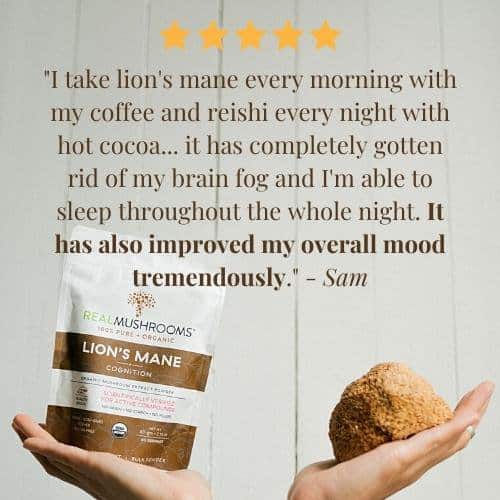
Did you know that the scientific name of the lion’s mane mushroom, Hericium erinaceus, literally translates to hedgehog in Latin?
This is because it’s thought to look like a faceless hedgehog.
Perhaps you might think this mushroom looks more like a lion’s mane, as it’s commonly referred to. Or do you think it looks more like a beard, or a monkey head, which are all names synonymous with Hericium erinaceus?
Today, we’ll delve deeper into the unique characteristics of lion’s mane mushroom and explain how there’s more to this fungi than the brain-supporting properties it’s known for. We’ll also explore:
As mentioned earlier, Hericium means hedgehog in Latin. Mushrooms in the genus, including the lion’s mane mushroom, have icicle-like structures that resemble a hedgehog’s spines, making them easy to misidentify.
Other than Hericium erinaceus, mushrooms in the Hericium genus include:
The bear head tooth fungus grows on living or dead hardwood species and softwood trees as well.
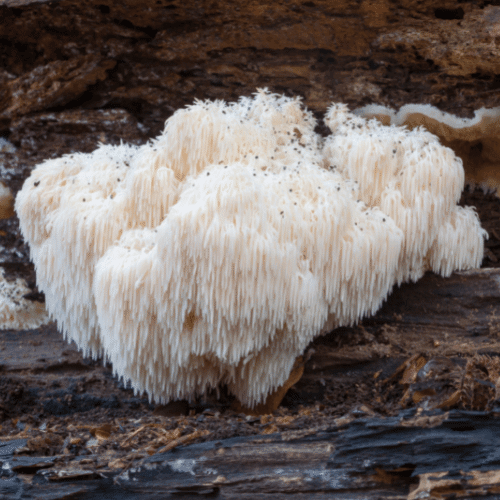
This mushroom is also known as the coral tooth fungus and bears a resemblance to a branched hard coral—hence the name.
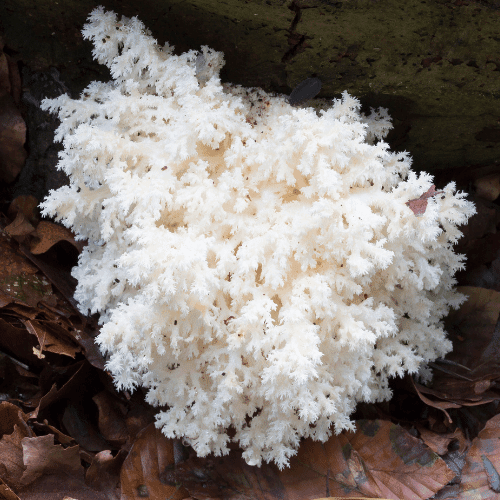
Now that we’ve learned about the two lion’s mane mushroom lookalikes, let’s explore how to identify the lion’s mane mushroom and what distinguishes it from these doppelgangers.
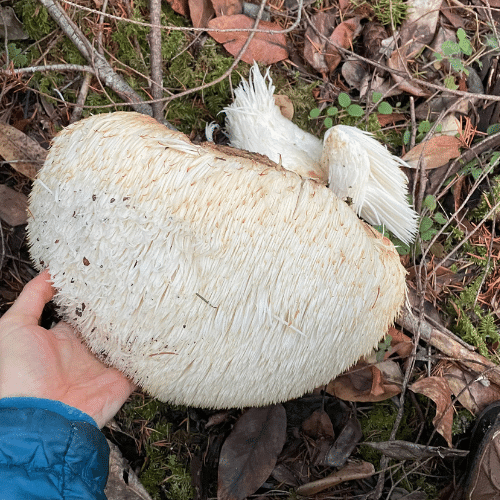
The lion’s mane mushroom grows on decaying or live deciduous trees and can also be found on beech and oak trees. It appears widely throughout North America, Canada, Europe, and Asia.
This mushroom can be found on fallen logs or much higher on a living tree’s trunk. It's a cool-weather mushroom and can be found in late summer and fall in North America or in winter and spring in warmer climates.
It has the following characteristics:
Let’s now take a look at how all the other common names for H. eracineus describe its features.
The key identifying feature of the lion’s mane mushroom is its snowball-like shape, from which the spines emanate.
Both H. americanum and H. coralloides spines grow from branches that emerge from the stem or other branches. But, H. erinaceus doesn't branch and its spines hang from a central stalk.
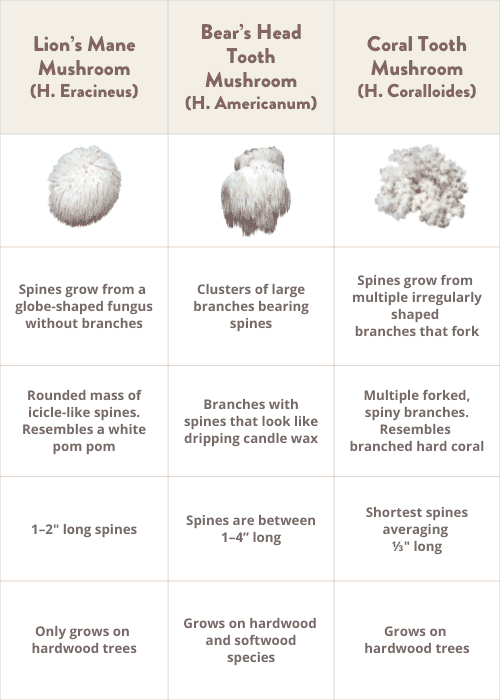
Expert tip: Though the genus name Hericium means hedgehog in Latin, only lion’s mane (H.erinaceus) is referred to as hedgehog mushrooms.
Note: There's a completely separate mushroom known as the hedgehog mushroom that has a cap-and-stem mushroom shape with “teeth” instead of gills on its underside. However, this mushroom isn't in the same family as the Hericium. It belongs to the Hydnaceae family instead. As a cousin of chanterelle mushrooms, it is likewise a delicious edible mushroom.
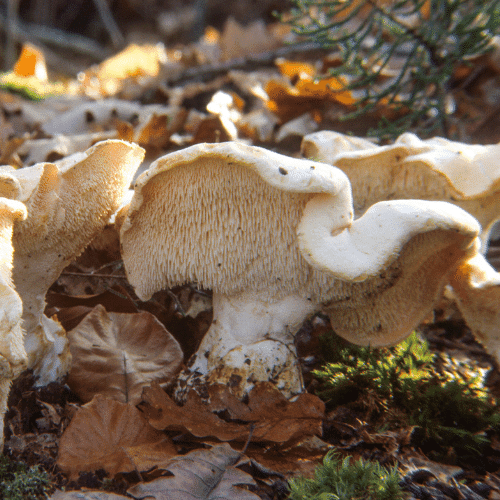
Fortunately, none of the lion’s mane mushrooms lookalikes are poisonous.
These three species in the Hericium genus are edible and they can be used for culinary purposes.
Lion’s mane mushrooms are not only delicious but also have a rich nutritional profile, which makes them an ideal culinary mushroom.
Most people claim they have an earthy taste with a hint of seafood flavor, but apart from taste, what really matters is their nutritional value.
Like the other culinary functional mushrooms, such as shiitake and maitake, lion’s mane is an ideal source of protein, fiber, and other nutrients essential for a healthy diet [1].
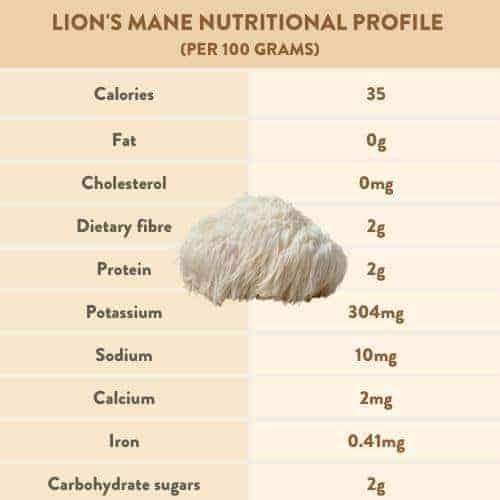
Comparative to lion’s mane mushroom (H. erinaceus), there is little research on the nutritional and medicinal properties of its lookalikes, H. coralloides and H. americanum. One exception concerns the antioxidant properties of these mushrooms. There is more than one study to confirm the high antioxidant content of H. coralloides and H. americanum [5,6]. In fact, one study found that H. coralloides has even higher levels of antioxidants than lion’s mane.
However, lion’s mane mushroom is the mushroom that has been extensively cultivated, so it is the Hericium mushroom that you can find and buy most easily. Take advantage of the accessibility of lion’s mane to tap into this rich source of antioxidants and nutrients.
Hericium mushrooms also contain compounds known as hericenones and erinacines [2]. The lion’s mane mushroom has been used extensively to study these compounds.
Studied effects of hericenones and erinacines:
So, are these lion’s mane mushroom benefits from the hericenones and erinacines interchangeable with the other mushrooms in the Hericium genus? There is very little research yet to guarantee that this is true.
However, one study identified compounds unique to H. coralloides that appear to have qualities that induce nerve growth and brain-derived neurotrophic factor [4]. The compounds in lion’s mane are similar and induce the same kinds of effects. Both these mushrooms’ compounds have implications for supporting brain and nervous system health. The study’s findings further support Hericium as a genus of mushroom that has brain-boosting properties.
Fortunately, foraging is not the only way to get fresh lion’s mane mushrooms because they are sold in grocery stores and farmers’ markets. You, however, have to ensure you buy organic mushrooms.
Mushrooms are very absorbent and will soak in pesticides and pollutants when grown inorganically. These chemicals are almost impossible to wash off once absorbed by the fungus, and you might end up ingesting them in your cooked lion’s mane mushrooms.
To ensure you buy organic fresh lion’s mane mushrooms, check food markets that sell organic foods.
If you’re in the United States, ensure that the mushroom packaging has an organic seal from the United States Department of Agriculture (USDA). This proves that the mushrooms are organically farmed, have passed inspection, and were grown using natural processes.
Alt: fresh lion’s mane from grocery store with organic seal
If you can’t find fresh lion’s mane from grocery stores in your area, consider growing your own. You can easily order lion’s mane mushroom growing kits online.
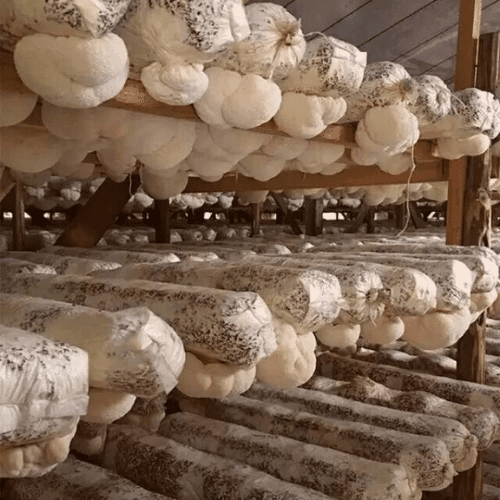
While adding fresh mushrooms to your diet is a good way to get their nutritional benefits, you won’t be getting all of the lion’s mane mushroom health benefits this way. Your body can’t absorb most of the active compounds from the cooked mushrooms.
Active compounds such as hericenones, erinacines, and beta-glucans are responsible for most of the lion’s mane mushroom health benefits, like its brain-boosting traits.
These compounds need to be extracted with the use of specific mushroom extraction processes suitable for lion’s mane.
Extract powders have a higher bioavailability of active compounds, which means your body gets all the benefits of these functional mushrooms.
However, you should exercise extra caution when you are buying a lion’s mane supplement since not all supplements are made equal.
Some are made from non-organic mushrooms, while others are made from mycelium (the “root system” of the mushroom). Using a mycelium-based supplement means you get more starch than health-benefiting compounds.
Consider the following while picking a lion’s mane supplement for the first time:
This buying guide for lion's mane mushroom powder extracts provides more details on why each of the above factors is crucial. Following it will ensure you get a lion's mane powder extract that has the beneficial compounds you require to reap the lion's mane's broader health advantages.
Real Mushrooms provides Organic Lion’s Mane Extracts in powder and capsule form.
We use the hot water extraction method to ensure our supplements have a high beta-glucan content of more than 25%. Beta-glucans are the primary compounds in mushrooms that account for most of their health benefits.
These qualities make our supplements the best on the market and efficient in boosting overall brain power, mental focus, and clarity.
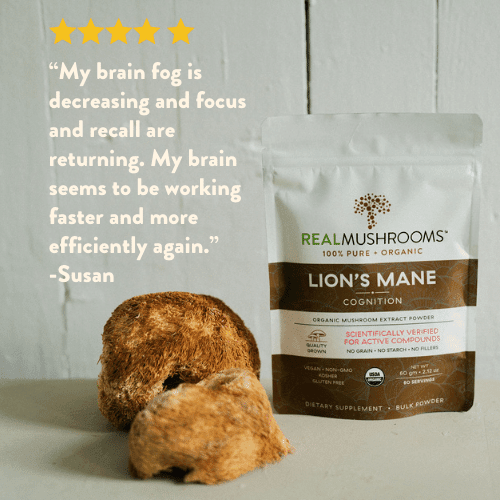
Order your first bottle of the Organic Lion’s Mane Extract Capsules, and enhance your brain power and memory.

1. Vikineswary Sabaratnam, Wong Kah-Hui, Murali Naidu,and Pamela Rosie David (March, 2013). Neuronal health – Can culinary and medicinal mushrooms help? Retrieved Sep 2, 2022, from https://www.ncbi.nlm.nih.gov/pmc/articles/PMC3924982/#ref4
2. Puei-Lene Lai, Murali Naidu, Vikineswary Sabaratnam, Kah-Hui Wong, Rosie Pamela David, Umah Rani Kuppusamy, Noorlidah Abdullah and Sri Nurestri A Malek ( June, 2013). Neurotrophic properties of the Lion's mane medicinal mushroom, Hericium erinaceus (Higher Basidiomycetes) from Malaysia. International Journal of Medicinal Mushrooms. Retrieved Sep 1, 2022, from https://www.dl.begellhouse.com/journals/708ae68d64b17c52,034eeb045436a171,750a15ad12ae25e9.html
3. Spelman, K., Sutherland, E., & Bagade, A. (2018, December 6). Herbal Medicine for Alzheimer's disease: Lion’s mane (hericium erinaceus). Restorative Medicine. Retrieved Sep 2, 2022, from https://restorativemedicine.org/journal/neurological-activity-lions-mane-hericium-erinaceus/#:~:text=In%20Chinese%20and%20Japanese%20medical,%2C%20general%20vigor%2C%20and%20strength
4. Wittstein, K., Rascher, M., Rupcic, Z., Löwen, E., Winter, B., Köster, R. W., & Stadler, M. (2016). Corallocins A-C, Nerve Growth and Brain-Derived Neurotrophic Factor Inducing Metabolites from the Mushroom Hericium coralloides. Journal of natural products, 79(9), 2264–2269. https://doi.org/10.1021/acs.jnatprod.6b00371
5. Atila, F. (2019). Comparative evaluation of the antioxidant potential of Hericium erinaceus, Hericium americanum and Hericium coralloides. Acta Scientiarum Polonorum. Hortorum Cultus, 18(6), 97-106.
6. Zhang, J., Zhang, J., Zhao, L., Shui, X., Wang, L. A., & Wu, Y. (2019). Antioxidant and anti-aging activities of ethyl acetate extract of the coral tooth mushroom, Hericium coralloides (Agaricomycetes). International Journal of Medicinal Mushrooms, 21(6).
What happens when you combine the addictive flavors and textures of avocado toast with a delicious (and brain-boosting!) mushroom? You get Lion’s Mane Mushroom Avocado Toast!
Lion’s mane mushroom might not be the most common culinary mushroom, but it will take your cooking to a new level. In this recipe, it will help you takes your love affair with avocado toast a step further and invites a brain-boosting and delicious ingredient to the party - Lion’s Mane Mushroom.
If you’ve been searching for a satisfying and healthy way to enjoy some delicious and brain-supporting lion’s mane mushrooms, look no further. Imagine a lightly toasted, open-faced sandwich topped with mashed avocado, garlic, lemon, cucumber, parmesan cheese, and the star ingredient - Lion’s Mane Mushroom.
This star ingredient is not only known for its delicious flavor, but the lion’s mane mushroom has a myriad of health benefits, too. Research suggests that Lion’s Mane may support your brain health and gut health, and provide you with anxiety, irritation, and frustration relief.
More specifically, this mushroom boosts your brain health by increasing the production of nerve growth factor, countering oxidative stress in the brain, supporting short and long-term memory, enhancing cognitive function, and regulating emotions.
Lion’s Mane also promotes a healthy immune response by regulating bacteria in the gut and intestines.
Now that’s a mouthful of benefits, and the great news is that you get all of them in a mouthful of delicious taste, thanks to the Lion’s Mane savory, almost crab-like flavor. (As you can see in the video, it even resembles crab once torn up!) Think juicy, delicate, tender, and meaty! Think delicious!
Although the video showcases freshly-foraged Lion’s Mane, your best bet is to find organic Lion’s Mane at a local grocer, health-food market, or farmer’s market. They are sometimes sold at Asian markets as well, just make sure they are organically grown because they are very absorbent, and you don’t want them to have absorbed a bunch of pesticides, pollution, and chemicals. No amount of washing will rid the mushroom of those harmful toxins.
And if you really want to dive into the mushroom world, you can also grow them yourself with a mushroom growing kit.
Once you have your fresh Lion’s Mane, you don’t want to use a water bath or “wash” it with water because it will absorb too much liquid. Instead, try brushing off any dirt with a dry sponge or soft brush (this is another reason why you want to buy organic !). Once you’ve cleaned the Lion’s Mane, tear the mushroom into bite-size pieces, discarding any overly brown bits. Once torn up, you’re ready to cook them!
There are many delicious recipes out there, but for this Lion’s Mane Mushroom Avocado Toast, you will stir fry them in butter or olive oil on medium heat, tossing frequently. Fry until golden brown, season, and try not to immediately devour them all before you put them on your avocado toast (easier said than done!)
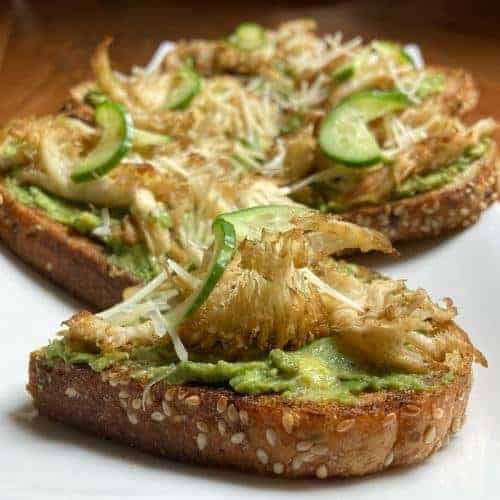
Learn more delicious ways to use lion’s mane in our article, Lion’s Mane Recipes: 7 Creations Using This Unique Mushroom!
What would we do without our furry friends?
Those gentle snuggles after a stressful Monday and giant welcome-back hugs at the airport make life all the better.
Simply put, pets are family. This is why we’re always looking to keep them healthy, and mushroom extracts are a versatile way to do that.
Unfortunately, not all mushroom supplements work. Some contain diluting fillers that limit their bioactive compounds and functional benefits.
To help you pick the best mushroom supplement for your pets, we’ve gathered information about three types of mushroom extracts: Turkey Tail, Reishi, and Lion’s Mane. As we go over their features, you’ll learn:
But first, let’s look at the different types of mushroom supplements and their uses.
There are various options for mushroom supplements with different bioactive compounds and benefits.
However, all medicinal mushrooms contain beta-glucans that can stimulate your pet’s immune system.
The following table highlights three mushroom supplements and the various needs they support:
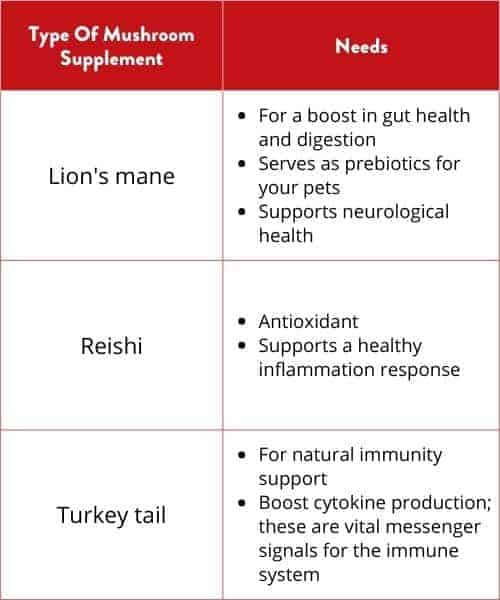
Let's delve into these mushroom supplements and their features.
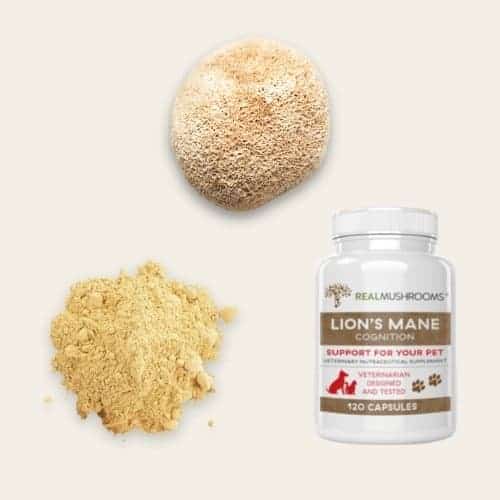
Lion’s Mane Extract from Real Mushrooms is produced using hot water to break down the fibrous cell walls to release this mushroom's bioactive molecules
This method is called hot water extraction and results in concentrated levels of beta-glucans which have important immune system benefits. Beta-glucans help train your pet's immune system to be vigilant and to defend against possible challenges to it, among other benefits.
To get an idea of how pet owners have been using Lion’s Mane for their furry loved ones, read their reviews and latest prices:
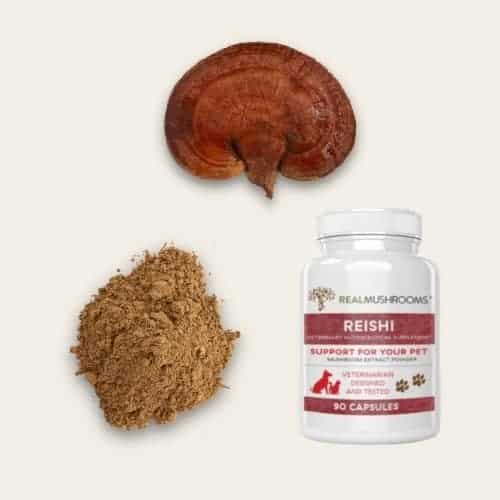
Reishi Capsules from Real Mushrooms are produced using hot water and alcohol. The hot water extracts the water-soluble compounds of Reishi mushrooms while the alcohol pulls out the water-insoluble components.
This procedure leads to a wholesome supplement with various bio-actives, from immune-boosting beta-glucans to triterpenes that promote a healthy inflammation response in your furry one.
For instance, Reishi Capsules have triterpenes (defensive compounds) such as ganoderic acids, which are non-water soluble and best extracted using alcohol.
The Reishi Mushroom Capsules give you additional active ingredients, but if you want to learn more, read their reviews and latest prices.
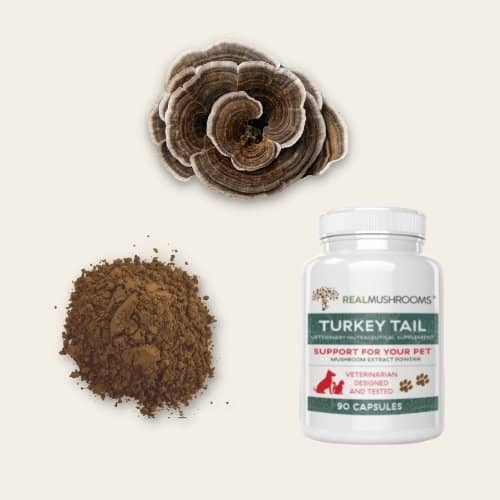
Similar to Lion’s Mane, Turkey Tail Extract by Real Mushrooms is also produced by hot water extraction.
This process keeps beta-glucan levels high (at over 30%). Turkey tail is the subject of more scientific studies than any other functional mushroom. Time and again it has shown its effectiveness in supporting the immune system, even among animals.
You’ll get more beta-glucans with Turkey Tail Extract, but if you want to learn more, check out the reviews and latest prices.
Mushroom supplements such as Lion’s Mane Extract can enhance your pet’s gut health. They contain oligosaccharides, which are natural carbohydrates that act as prebiotics (food for the good bacteria in your pet’s gut).
One study confirmed this fact when it concluded that feeding oligosaccharides to companion animals improved their microbial ecology and stool quality (1).
There are also human clinical studies showing Lion’s Mane can be highly beneficial in relation to gastrointestinal issues, and ulcers (2,3,4).
Mushroom supplements such as Turkey Tail Extract support your pet’s immune system by boosting the production of cytokine and T cells (one of the primary lymphocyte cells that form the immune response).
These supplements contain polysaccharide-Krestin (PSK), a compound that one study found to support T cell production.
Holistic vets like Dr. Rob Silver DVM, and Dr. Donna Kelleher DVM recommend Lion’s Mane extract for slowing the progress of neuro-degenerative ailments in dogs and cats such as Degenerative Myelopathy (a.k.a. Dog Lou Gehrig’s Disease) and Canine Cognitive Dysfunction (a.k.a. Dog dementia).
Using Lion’s Mane extract as a natural solution for pet neurological support is based on human and animal studies that have demonstrated the positive effects of this mushroom on protecting cognitive function, stimulating nerve growth, and even helping regenerate damaged nerves (5,6,7,8,9).
Giving your dog or cat a Lion’s Mane supplement is also a good preventative step for protecting their cognition and brain health as they age. Reishi is also useful as a stellar source of antioxidants for keeping neurons healthy as pets age.

The best mushroom supplements feature various bio-actives with different benefits, but they also share some features and advantages—for instance, they use the mushroom itself, not mycelium or fillers, and they have high beta-d-glucans content.
Here’s a deeper look at these features and their advantages.
For these fungal organisms, the mushroom, sometimes referred to as the fruiting body, is just one stage in its life cycle. It’s what you see growing above the ground and what you are buying in the supermarket. However, many so-called mushroom supplements sold in North America do not have mushrooms in them at all!
Instead, these companies use the root system of the mushroom, which is called the mycelium. Why? Because it is far more economical to produce mycelium than to grow mushrooms in full.
Mycelium for supplements is typically grown in a grain-based substrate (the medium the mycelium grows on). When harvesting the mycelium, the grain is not separated from the mycelium and goes straight into the final product. This grain is just filler and provides no health benefits.
Between the grain-based filler and the lack of mushrooms, many supplements contain low concentrations of beneficial compounds from fungi, and high concentrations of starch.
We provide a detailed breakdown of the key differences between the mushroom (fruiting body) and the mycelium (vegetative body) in our article Medicinal Mushroom Benefits: Mycelium vs Fruiting Body.
Top mushroom supplements are processed without mycelium, chemical additives or preservatives. They use only the mushroom.
Here’s an example of a label from Real Mushrooms that clearly indicates the product is made of 100% mushrooms, not mycelium, and with no added fillers or starches of any kind (green arrow).
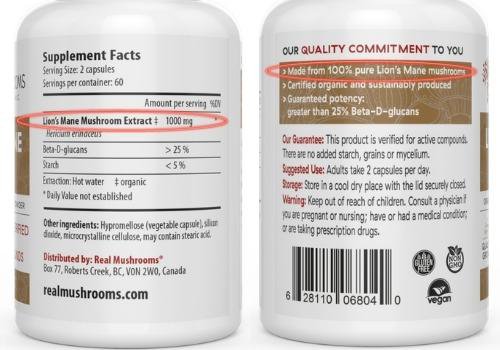
These are common polysaccharides (carbohydrate arrangements) found within the cell walls of mushrooms and in supplements.
Beta-d-glucans serve your pet by turning the immune system up or down (immunomodulation) among other benefits, but this effect isn’t consistent across all mushroom species and supplements.
Immunomodulation depends on factors such as:
Expert Tip: Check the label on your mushroom supplement before purchasing to ensure you’re getting the highest quality. The best manufacturers document the levels of bio-actives present in their products.
The most common talking points on mushroom supplements for pets among users were regarding:
"My dog has been taking Turkey Tail for three weeks and I see a dramatic improvement in her energy level." Ellie, Turkey Tail Reviewer
"My dog is almost 17 and I am excited to find a supplement that has taken years off his age." Stacy, Lion’s Mane Reviewer
"My senior foster is very unsettled at certain times of the day. These chews help her relax and settle down." Beth H, Mushroom Relax Pet Chews Reviewer
Yes, you can. In essence, mushroom supplements are functional foods and work best when combined with a balanced diet.
This timeline is variable, but mushroom supplements like Reishi and Lion’s Mane can take effect after 2–3 weeks of daily use.
Most mushroom extracts can be taken once a day and still be effective. Check the labelling on your supplement to confirm the recommended dosage.
Some of the functional mushrooms are too tough to be edible (i.e. reishi and turkey tail). Also, mushroom supplements are made with an extraction process that makes the natural compounds within mushroom more accessible to your pet’s body. Otherwise, these valuable compounds would remain trapped behind chitin fungal walls—the same tough substance that makes up crustacean shells—and undigested.
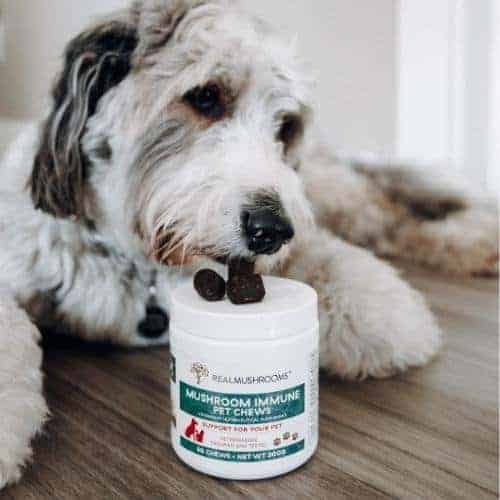
So there you have it—three needs uncovered by three types of mushroom supplements: Lion’s Mane, Reishi, and Turkey Tail.
Whichever option you choose, consider the following:
At Real Mushrooms, our goal is simple: to offer high-quality supplements from actual mushrooms. This stems from the industry problem of diluted supplements.
A recent study of mushroom supplements found that 74% of Reishi products are inauthentic. Most contain diluting fillers such as grain and mycelium.
Dilution causes higher concentrations of alpha glucans and lower levels of crucial beta-glucans. As such, these supplements offer little value to your pets.
Real Mushrooms supplements are made solely from mushrooms (the fruiting body). This reality is why we list the scientifically verified ingredients and active compounds on our products. unlike most companies.

Thinking about cooking lion’s mane mushroom? Maybe you’ve heard of some of the health-supporting benefits of lion’s mane and want to find some tasty ways to add them to your diet. Or perhaps you want to branch out from your standard portobello and button varieties and try your hand at a different gourmet mushroom. Whatever the reason, you’re in the right place to learn how to make the most of cooking this versatile, delicious mushroom.
Along with a couple of simple recipes, we’ll cover where to buy lion’s mane and how to clean, store and prepare it. We’ll also briefly review some of the fascinating ways this mushroom can support your health. Read on to learn everything you need to know to begin cooking lion’s mane mushroom.
What’s in this article:
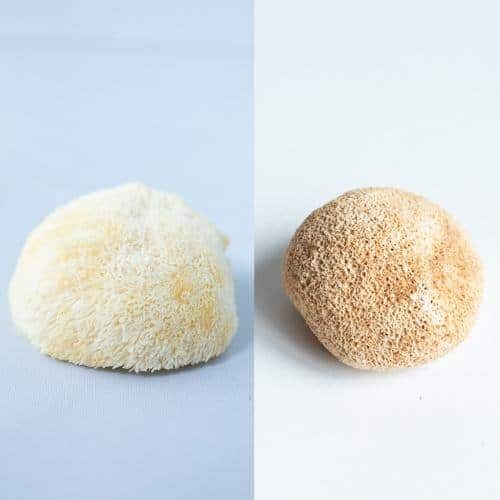
Lion’s Mane (Hericium Erinaceus) is a common mushroom found throughout the Northern United States and Canada. They’re often found growing on dead and decaying trees, as well as birch, beech, elm, and oak trees.
The lion’s mane mushroom gets its name from its shaggy, mane-like appearance. They are large, white, and covered with hair-like structures called teeth that hang down around the mushroom. Its fuzzy appearance is also what earned it the nickname the bearded hedgehog mushroom and the pom-pom mushroom.
This unique mushroom is used all over the world for culinary purposes and for its health-supporting properties. It’s a versatile mushroom and can be enjoyed raw, cooked, dried, or steeped as a tea. Lion’s mane extracts are often used in supplements for health support.
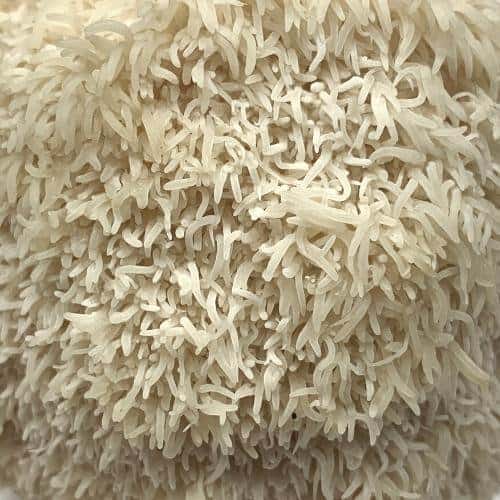
Most of us would like to receive more health benefits from our food, which is one advantage of cooking with lion’s mane mushrooms (another is that they’re delicious!). From brain health to gut health, to being possibly one of the best mushrooms for anxiety, there are a lot of reasons to eat more lion’s mane.
Lion’s mane mushroom has a long history of use in Asian medicine. In Chinese and Japanese medicine, it has traditionally been used to support spleen and gut health. Traditional Chinese Medicine practitioners employ this mushroom to promote good digestion, vigor, and strength (1).
Modern research suggests that lion’s mane mushrooms may be able to support your health in a variety of different ways. One of the most exciting discoveries made about them is their potential to support brain health.
Lion’s mane mushrooms contain two unique compounds that may be able to protect the neurons and nerves in our bodies. These compounds are called hericenones and erinacines. Studies show that these compounds may be able to protect the brain from cognitive decline associated with aging (2).
Studies show that lion’s mane can increase the production of nerve growth factor (NGF), a compound that maintains neural health in our brains (3). This compound is linked to supporting the growth of nerve tissue and nerve function as shown in animal studies (2).
Research suggests that this mighty mushroom may be able to support brain health in other ways including:
Lion’s mane may be one of the best mushrooms for anxiety. In a clinical trial, lion’s mane mushroom was able to decrease feelings of anxiety, irritation, and frustration (6).
Lion's mane could support your health in other areas of your body as well. For instance, it can promote a healthy immune response. Studies show that it can do this by regulating bacteria in the gut and intestines (7). Animal studies show that these mushrooms can support immune system strength by regulating intestinal mucosal activity (8).
Cooking with lion’s mane mushrooms is also a fantastic way to get more nutrients in your diet. Mushroom proteins contain all the essential amino acids your body needs to stay healthy. Amino acids are the building blocks of each individual cell, and finding complete sources of all essential amino acids is required to give your body the fuel it needs to function.
Together with the low-fat content and high proportion of polyunsaturated fatty acids, these nutritional properties add to the significant health value of lion’s mane mushrooms. When reliable extraction methods are used, lion’s mane extract can be used as a supplement to more easily tap into some of the desirable health benefits mentioned above (9).
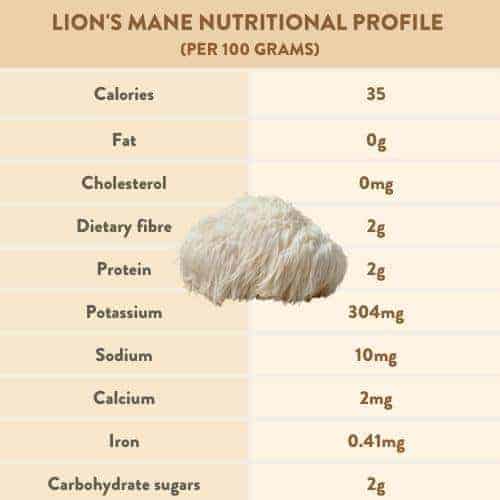
If you’ve never tasted lion's mane mushrooms before, you’re in for a treat. When it’s cooked it’s juicy, delicate, tender, and meaty. The taste of lion’s mane mushrooms is best described as seafood-like and it’s often compared to crab, lobster, and other shellfish. This is why it’s often used as a vegetarian substitute in seafood dishes.
You can purchase lion’s mane mushrooms fresh, dried, or as a powder. Each format is useful for different culinary purposes.
For instance, fresh and dried lion’s mushrooms may be better for frying and grilling, whereas powders may be better for broths, baking, and drink mixes.
Mushrooms are very absorbent which is great when it comes to marinades and sauces, but not so great when it comes to pesticides. That’s why it’s best to purchase organic lion’s mane mushrooms.
If you’re on the hunt for fresh or dried lion’s mane mushrooms, the first place to look would be your local health-food or farmer's market. They are sometimes sold at Asian markets as well, just make sure they were grown organically.
If you’re not having any luck finding them in your area, you can try ordering them online or growing your own. You can use a quick Google search to find fresh and dried lion’s mane and lion’s mane grow kits.
Organic mushroom powders can be found in some health food stores and easily online. However, if you are buying mushroom powders to support your health, it’s important to make sure you are buying the highest quality product. Check out our 4-point buying guide for Lion’s Mane powder extracts to learn how to spot a quality mushroom product.
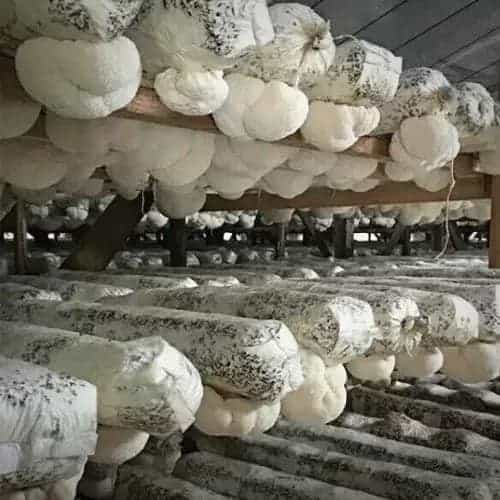
When cooking lion’s mane mushroom, fresh is best. But, you don’t want any extras to go bad before you can enjoy them. If you’re not planning on eating them right away, you’ll need to store them properly.
If you plan on eating your fresh lion’s mane mushrooms within a few days, storing them in your refrigerator is fine. Store them in a roomy paper bag so that they can breathe. Keep them away from water and other liquids to prevent mold from developing.
As they age, lion’s mane mushrooms will begin to turn yellow. You can cut off any yellow parts to preserve their flavor. If they turn orange, feel soft or slimy, or show signs of rot, it’s time to throw them out.
With proper storage, fresh lion’s mane can last for about a week in the fridge. If you’re not planning on using them that soon, you’ll need to consider other storage options.
One option is to dry them, but first, you’ll need to clean excess dirt off them. You can do this by rinsing them off with water, or by using a mushroom brush to gently sweep off any particles. If you rinse them in water, let them sit in the sun for a couple of hours so excess water can evaporate.
Once your mushrooms are clean, you can dehydrate them in an oven or a food dehydrator. Using a shape knife, cut the lion’s mane from top to bottom about a quarter of an inch thick. Then place them on dehydrator trays or parchment-lined baking trays in a single layer so the slices don’t touch each other.
If you’re using a dehydrator, set the temperature to 135 degrees for four to six hours. You can dehydrate the mushrooms at a lower temperature for a longer period of time if you want your pieces to be less firm and more delicate. If you’re using an oven, set it to the lowest temperature and let the lion’s mane dry for two to four hours.
When you can easily snap the mushrooms between your fingers, they’re ready. Let them cool and place them in canning jars or storage bags. You’ll want to make sure the containers you store them in are air-tight to reduce the risk of them going bad. With proper storage, dried lion’s mane mushrooms can last indefinitely.
Another option is to freeze your lion’s mane mushrooms. Because of their high water content, it’s best to sauté them before freezing. Cook them as you normally would, or use our sauteed lion’s mane recipe below, and then let them cool. When ready, put them in an airtight freezer bag or a vacuum-sealed bag to prevent freezer burn, and store them in your freezer for up to a year.

Cooking lion’s mane mushrooms is as easy as it is delicious. The best way to cook lion’s mane mushrooms is to sauté or roast them. Once they’re cooked, you can eat them in a sandwich, stir-fry, or on their own.
Sauteeing or roasting is a great place to start if you’ve never cooked lion’s mane mushrooms before. If you’re feeling more adventurous, you could try making your own lion’s mane “crab” cakes with them, or using them in a vegan lobster roll.
Before you cook your lion’s mane mushrooms, you’ll need to prep them. Rinse them in water or use a mushroom brush to remove any excess dirt. If you rinse them, set them out to dry for a couple of hours, preferably in sunlight so the extra water evaporates.
The bottom of the mushroom is likely dirty and maybe a little tough. You’ll want to cut that piece off and any other dirty or yellowing spots.
Depending on the dish you’re using your mushrooms in, you can either cut them into slices or shred them into pieces.
If slicing, use a chef's knife to cut the mushroom in half from top to bottom. From there, you can cut it into half-inch segments for a thicker slice, or quarter-inch segments for a crispier slice. If shredding, you can simply use your hands to pull the mushroom apart into bite-sized pieces. Just like with slicing, the smaller you shred the mushroom, the crispier it will be.
Sauteing is an easy and quick way to prepare lion’s mane mushrooms. Here is a simple and tasty recipe for sauteing mushrooms.
Ingredients:
Directions:
Roasting is a decadent way to cook lion’s mane mushrooms without having to do a ton of prep work. Try this method to impress your friends and family at your next dinner party.
Ingredients:
Directions:
We’ve assembled a collection of 7 more delicious meals that you can make using this mushroom in our article Lion’s Mane Recipes: 7 Creations Using This Unique Mushroom.
We've also combined the addictive flavors and textures of avocado toast with this brain-boosting mushroom in our Lion’s Mane Mushroom Avocado Toast Recipe. Give is a try for yourself!
We hope you have fun trying these tasty lion’s mane recipes! We’d love to hear how they worked for you, share you’re mushroom dishes in our Facebook Group or on Instagram, and don’t forget to tag @Real_Mushrooms.
This feature about the benefits of Lion’s Mane for dogs was written by Real Mushrooms’ resident Registered Veterinary Technician (RVT), Joni Kamlet. Learn more about Joni’s 20 years of experience in animal care, canine rehabilitation, and pet health product development here.
An Ode to Lion’s Mane…
Beloved Lion’s Mane..
You are so good for my brain
You are the mushroom that lit my fungi fire.
The more I learn about you, the more I desire
We now have Lion’s Mane in our Real Mushrooms pet line repertoire…
Ok, clearly I’m not a poet. But I do LOVE Lions Mane! Here is my story why:
Lion’s Mane is my gateway mushroom. It is the mushroom that totally upended my life (in a good way!). Lion’s Mane is my doorway to total mushroom obsession, causing me to leave my former job, buy 5 acres of mushroom filled woodland in Virginia, and campaign Skye Chilton, Dr. Rob Silver and the Real Mushrooms team to let me come work with them on Real Mushrooms’ new veterinary product line.
I came to learn about the wonderful possibilities of Lion’s Mane mushrooms for supporting the mind and cognition of pets in 2020. I was working in product development for a company that was making mushroom supplements. Since then, I have been blown away by the testimonials of pet parents who give this mushroom supplement to their dogs.
While learning about Lion’s Mane I became very excited about the possibility that it could support dogs with degenerative myelopathy (DM). Similar to Lou Gehrig's disease in humans, DM is a neurodegenrative disease with very few supportive options.
DM slowly attacks a dog’s central nervous system by stripping away the protective coating called myelin. This leads to a breakdown of the white matter in the spine which controls movement. Early signs manifest as dragging of the hind limbs, a kind of “drunken sailor” walk. These dogs eventually lose fecal and urinary continence. Eventually, as the disease progresses, the animal can no longer stand or support their body weight. My background as a Veterinary nurse specializing in canine rehabilitation involved working with many of these DM dogs. I know intimately how frustrating and heartbreaking a disease it is.
In vitro studies of Lion's mane mushroom show that it supports the regeneration of the myelin sheath (1). It was for this reason that I was very excited to see how Lion’s Mane would work with these DM dogs. I encouraged a group of veterinarians I was working with to try the Lion’s Mane supplements with their DM patients.
Truth be told, the feedback on how Lion’s Mane affected dogs with DM was inconclusive, but the overwhelming feedback I got was that the dogs on the Lions Mane products were exhibiting better cognitive function, and it was observable.
WOW-This got my attention! Could Lion’s Mane be beneficial for older dogs showing signs of dementia?
Canine cognitive dysfunction (CCD) is also known as dog dementia. However, cats can also suffer from this condition. CCD is a growing area of concern in the veterinary community. Just like humans, as animals get older, they can develop Alzheimer’s-type symptoms.
Aging is the main risk factor for CCD with 28% of dogs in the 11–to-12-year-old range, and 68% in dogs 15 years old and higher showing signs of CCD (2). Cats fared a bit better with 36% of 11–to-21-year-old cats displaying signs of dementia. (3)

Canine cognitive dysfunction can manifest as the following symptoms:
Let's go back to the group of veterinarians that I mentioned earlier in this blog. Here is some of the feedback I received from them regarding the Lions Mane supplement and how it affected their animal patients with dementia. Please note that this was not a clinical study. This is information that pet parents shared with their veterinarians after using the product for a few weeks.
Improvements noted in dogs:
Given the fact that Lion's Mane is safe for dogs and cats and mild tasting, I think it's an excellent addition to our veterinary offerings. Since Lion’s Mane powder extract has a subtle seafood flavor, cats should readily take to it.

Hericium erinaceus is mostly referred to as Lion’s Mane, but can also be known as hedgehog fungus, monkey head mushroom, pom pom mushroom. This fungus is a good example of the doctrine of signatures, as it resembles a brain.
Currently one of the most popular of functional mushrooms, it is relatively new to researchers since it is quite a rare find in nature. The ability to cultivate it on a large scale commercially for medicinal and culinary use has significantly added to its current popularity. Unfortunately, the relative newness of this fungi on the Western market means fewer completed clinical studies. Sadly, there are no clinical studies in dogs and cats yet. However, there are other animal studies that point to the interesting possibilities for this mushroom to be used for enhancing the quality of cognition in pets.
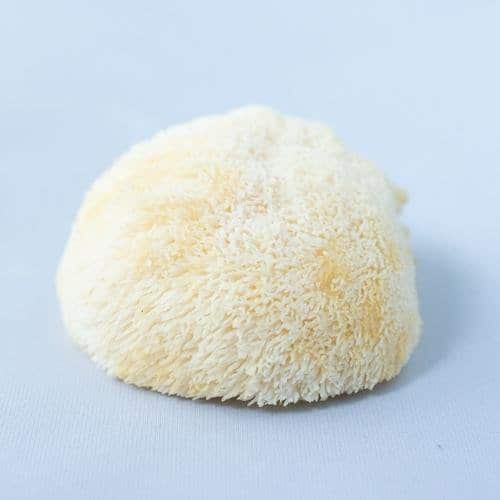
Lion’s Mane has been traditionally used in China and Japan as food and medicine to support gut health, nervous system weakness and debility, even wound healing. It is also used to support the spleen, nourish the kidneys and it has an affinity for the lungs. There are clinical studies showing Lion’s Mane can be highly beneficial in relation to inflammatory bowel disease, gastrointestinal issues, and ulcers (4).
One of the great benefits of Lion’s Mane, like the other medicinal mushrooms, is that it is very effective at promoting a health inflammatory response in general. This mushroom is also considered an adaptogen that can help regulate the immune system.
Lion’s Mane has been receiving a lot of attention in relation to its effect on brain function and cognition. This is a relatively new use for this mushroom, and is related to discoveries around its effect on Nerve growth factor (NGF) in the 1990’s. More recent clinical studies have supported this discovery (5).
Human clinical studies have shown Lion's Mane to be anti-depressive and anxiolytic, improving scores on anxiety and depression scales (6). Human studies have also demonstrated that Lion’s Mane can support better memory recall in aging people with mild memory issues (7,8).
I would readily use Lion’s Mane for pets with behavior issues, cognitive dysfunction, any type of GI issues, to support immune health, to support calming. I would definitely use it with DM dogs in spite of the mixed results I received initially.
Learn more about the ways this unique fungus can support health in our article, Lion’s Mane Mushroom Benefits: A Complete Supplement Guide.
Lion’s Mane is a delicious culinary mushroom that is increasingly available at farmers markets and specialty grocery stores. Like other edible mushrooms that humans can eat, Lion’s Mane is indeed safe for dogs and cats to consume.
However, it is important to cook Lion’s Mane mushroom before giving it to your pet because it can be difficult to digest in raw form.
Now, there is an easier way to serve up this functional mushroom to your pet. If you are hoping to use this mushroom as a means of improving you pet’s health, you can use a concentrated mushroom powder extract.
Real Mushrooms now provides its renowned mushroom powder extracts in a format suitable for giving to pets. Read below for more details about this functional supplement and how to give it to your pet.
The Organic Lions Mane Extract Capsules for Pets by Real Mushrooms is ideal because it is pre-measured to make it suitable for animal dosing.
The Real Mushrooms line of pet supplements has the same high concentration of beta-glucans as its regular line of mushroom powders. There are no fillers or unnecessary additives and the supplement is made from 100% Lion’s Mane mushroom, not mycelium.
Learn more about how to identify a quality Lion’s Mane extract for your pet by reading our article Find the Best Lion’s Mane Supplement: The 4-Point Buying Guide.
Conveniently, using Real Mushrooms’ pet-specific Lion’s Mane supplement makes the issue of dosing a breeze.
Dosing: 1 capsule for every 20-40 pounds of body weight or as directed by your veterinarian.
In the case of cats who are difficult to pill, simply break the capsule apart and sprinkle the powder on their food. The mild seafood taste of Lion’s Mane seems to appeal to cats.
Learn more about the benefits of mushrooms and mushroom supplements for dogs and cats in our other pet articles:
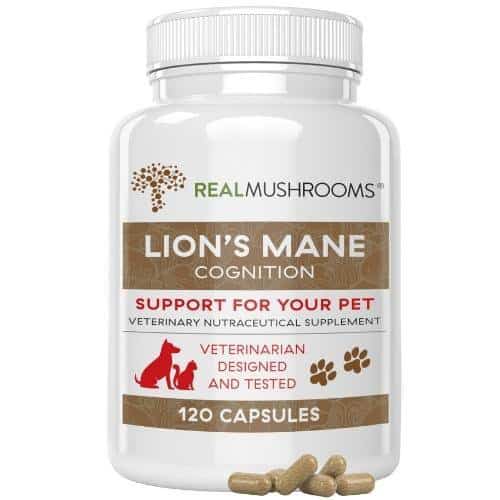
These 7 excellent Lion’s Mane recipes can help you elevate the fresh, dried, or powder versions of this health-supporting mushroom to new heights. Lion’s Mane mushrooms have been long sought after for their brain-supporting and immune system-boosting effects. They are also a satisfying substitute for meat and shellfish.
We will begin by giving you insight into Lion’s Mane mushrooms and why they’ve become so popular in the health and wellness space. Then we’ll cover how you can get your hands on the various forms of Lion’s Mane mushroom. And finally, we’ll present you with 7 mouth watering recipes to incorporate this functional mushroom into your diet.
Jump to our recipes section here.
Lion’s Mane (Hericium erinaceus) has a long history of being used as a brain-boosting edible mushroom. Chinese Buddhist monks used Lion’s Mane powder in their tea, claiming it helped them focus in their meditation and increase overall brain power (1). Modern science has set out to examine the validity of these claims and is finding promising results.
Compounds called hericenones and erinacines, when extracted and isolated from Lion’s Mane, have qualities that may protect neurons and nerves in our bodies. The unique neuroprotective effects of these Lion’s Mane compounds are speculated to shield the brain from normal mild cognitive decline associated with aging (2), help support healthy memory function and focus (3,4), and support a positive mood and relieve occasional stress (5,6,7,8).
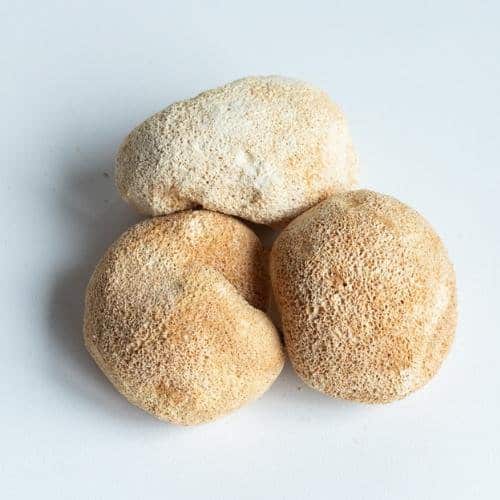
Lion’s Mane mushroom is linked to multiple potential health benefits beyond the cognitive and neurological world. Traditional Chinese Medicine has promoted the use of Lion’s Mane for thousands of years as a tonic for everything from digestive health to enhancing general vitality (2).
Below are some of the additional ways Lions’ Mane could potentially improve your health, according to modern scientific studies:
For more details about how and why Lion’s Mane can support the health of the mind and body, read our article Lion’s Mane Mushroom Benefits: A Complete Supplement Guide.
Lion’s Mane mushrooms are often used as a meat substitute because of their dense texture. Due to the uber-absorbent nature of mushrooms, it can be marinated to give it just about any flavor profile, including a meaty one (see our Lion’s Mane steak recipe below). Additionally, it can be prepared to bring out its natural, delicate, seafood-like flavor. So, it is also ideal as a shellfish substitute (see our Lion’s Mane faux crab cake recipe below).
You can also benefit from the loaded nutritional profile of this delicious mushroom. It is very dense in protein and fiber, which also makes it an ideal meat substitute for vegans and vegetarians. The nutritional chart below shows you how Lion’s Mane stacks up against other high-protein foods.
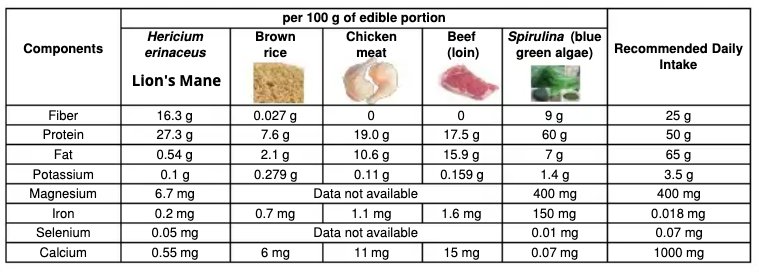
There are three formats of Lion’s Mane mushroom that are available commercially: fresh, dry, and powder. Each has their unique advantages and will be suitable for different culinary uses. Below we will detail how to find quality Lion’s Mane and how to prepare each type for consumption.
Ideally, when buying fresh Lion’s Mane, you would only purchase organic. Mushrooms are very absorbent. As a result, they are extremely susceptible to absorbing pesticides or pollutants they may be exposed to. No amount of washing will rid the mushroom of chemicals it has absorbed. It’s therefore best to buy organic to help ensure you are ingesting only pure mushroom goodness.
Typically, organic and health-food markets will be the likeliest to carry fresh Lion’s Mane. Some farmer’s markets will have vendors that grow mushrooms and you might locate some Lion’s Mane there. You may also find fresh Lion’s Mane in Asian food markets, however they will not necessarily have been grown organically.
If you really want to experience fresh Lion’s Mane and you live in an area where it isn’t sold, you can consider growing your own! The process of growing Lion’s Mane has been made easy by companies selling all-in-one growing kits.
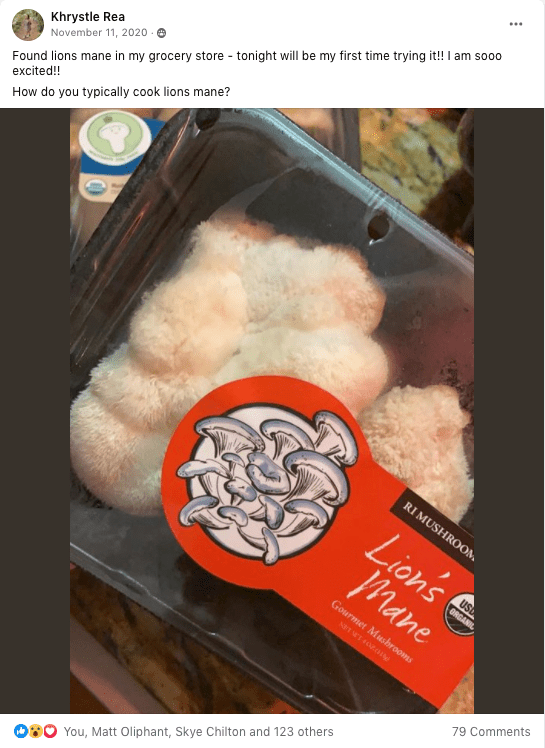
Store your fresh Lion’s Mane mushrooms in a single layer in a paper bag. Keep these in the refrigerator for up to a week, depending on the freshness when you purchased them. The mushrooms will begin to brown as they become less fresh.
Do not use a water bath or otherwise “wash” the fresh Lion’s Mane with water. It will absorb too much liquid. Instead, brush any dirt off your mushroom with a dry sponge or soft brush. Since you will be buying organic mushrooms, you do not need to worry about “washing” this furry fungi. Tear off any overly brown bits and you’re ready to cook!
See our 4 recipes for fresh Lion’s Mane mushrooms here.
If you cannot located quality, organic, dried Lion’s Mane in your local market you’re in luck! There are many online sellers of dried whole Lion’s Mane. A simple Google search will turn up several vendors. As we mentioned in the section about buying fresh Lion’s Mane, it is important to find an organic source to help ensure you aren’t going to potentially ingest unwanted chemicals or pollutants from this highly absorbent mushroom.
Dried Lion’s Mane mushrooms simply need to be re-hydrated for cooking purposes. Soak pieces of your Lion’s Mane in a bowl of water for about 30 minutes until they are plump. Use a strainer to remove your Lion’s Mane from the water, pat the pieces dry, and begin cooking! You can use the leftover soaking water as a mushroom broth.
Store dried Lion’s Mane away from heat and moisture (the enemies of your dried mushrooms). If you place them in an air tight container and store them in the freezer, they will keep well for between six months and a year.
Learn how to cook dried lion's mane mushroom.
Now, before getting into where to find Lion’s Mane powder, there is a distinction we need to make. There are two potential types of powders on the market:
This comes from the whole mushroom having been dried and ground down into a powder.
This comes from the whole Lion’s Mane and/or its mycelium (root system) having been soaked in hot water or alcohol (or both). The fibrous remains of the mushroom are discarded and the resulting liquid is evaporated. This process leaves behind a very concentrated powder where the medicinal compounds of the mushroom are retained.

You can find organic whole mushroom powder from online vendors relatively easily. However, there is a little more intentional selection necessary when buying a Lion’s Mane extract, especially if you want to use it for health-supporting purposes.
We have laid out a 4-point buying guide for Lion’s Mane mushroom powder extracts here. This guide will help to ensure you buy a Lion’s Mane powder extract that will actually deliver the helpful compounds you need for getting the health benefits from Lion’s Mane.
See our 3 delicious recipes using Lion’s Mane powder extracts here.
If you're a mushroom forager, you can try to find and pick lion's mane from the source. It grows in the northern United States and Canada on the dead, dying, or fallen hardwood like oak and beech. They can generally be found during cooler weather months, before frost sets in. In many areas where Lion’s Mane mushroom can be found, this means early-to-late fall, and for milder climates that could extend into December. There are no toxic lookalikes, so it is an easier mushroom to identify without risk of accidental poisoning.
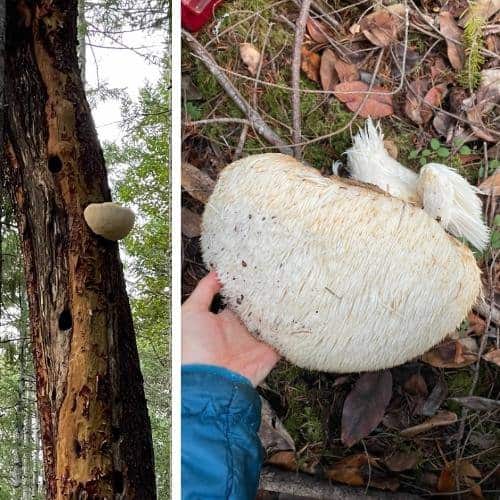
The following recipes work with either fresh or dried Lion’s Mane mushrooms. However, if you are using dried mushrooms, simply soak them in water for 30 minutes and strain them before cooking. Pat them dry before pan-frying.
You can make this recipe to enjoy the Lion’s Mane mushroom barbequed on skewers with a mix of vegetables, or add them to pita bread with tzatziki sauce to make yourself a Lion’s Mane gyro. This recipe is indeed vegan-friendly, and if you want, use this vegan tzatziki recipe.

INGREDIENTS
Marinade:
DIRECTIONS
This awesome “faux crab” recipe really highlights the sweet, light, shellfish flavor of the Lion’s Mane. It can be made completely vegan if desired. While there are many variations of Lion’s Mane “crab” cake recipes, this one from Jamie at So Happy You Liked It really stands out. We’ve made one adjustment: we steamed the mushroom rather than baking it so it truly retains its moist, shellfish-like texture.

INGREDIENTS
For the “Crab” Cakes:
For the Greek Yogurt Remoulade:
DIRECTIONS
For the Greek Yogurt Remoulade:
Combine all ingredients in a small bowl, whisking thoroughly to combine. Taste to the sauce, and adjust to your liking! Add more smoked paprika, salt, or perhaps even some mayo or a splash of lemon juice.
For the “Crab” Cakes:
Recipe Notes:
If you want to make these vegan, use a flax egg (1 tablespoon mixed with 3 tablespoons water) in place of 1 egg and use dairy free yogurt in the remoulade sauce. Note that I haven't tried the flax egg option - I would love to know your thoughts if you try it!
This recipe from master vegan “meat” wizard, Mark “Sauce Stache” Thompson, is about as delicious a steak reproduction you could come across using the dense, meaty Lion’s Mane.
INGREDIENTS
Marinade:
DIRECTIONS
As we mentioned in the section about the health benefits of Lion’s Mane, this mushroom has been used by cultures around the world for centuries. In the Chinese culture, for example, it was and still is commonly used in soup. We feel it’s important to include a soup recipe as a nod to the traditional heritage of this wonderful mushroom.
INGREDIENTS
DIRECTIONS
It is possible to find fresh Lion’s Mane at certain grocers or farmer’s markets, or to forage or grow it yourself. However, the easiest and most accessible way to benefit from the health-supporting effects of this mushroom is to take it as a supplement in capsule form or to add extract powder to your drinks and/or favorite recipes.
Here are some of the tastiest Lion’s Mane recipes our Real Mushrooms team has whipped up that makes use of our organic Lion’s Mane mushroom powder extract.
Recipes In This Section:
This delicious hot brew is a wonderful, stimulant-free, substitute for coffee to get your brain going for the day. It features the power of Lion’s Mane and Ashwagandha, another wonderful adaptogen to keep your body balanced and resilient to stress.
INGREDIENTS
DIRECTIONS
Find the original post here.
Three words: Cinnamon. Sugar. Donuts. Cue craving! We’ve all smelled the heavenly aroma of this magical combination. But we don’t usually associate those sights and smells with these three words: Healthy. Brain. Function. But, what if we told you all of those words can belong together, that you could have your donuts and your brain boost too? That’s where this baked Keto donut recipe comes in. These cinnamon “sugar” donut holes roll into play with their low-carb real food ingredients, healthy fats, and the secret ingredient known as the “Mushroom For the Mind.” It’s the sweetest of our Lion’s Mane recipes.
INGREDIENTS
Keto Donut:
Cinnamon “Sugar” Coating:
DIRECTIONS
Find the original post here.
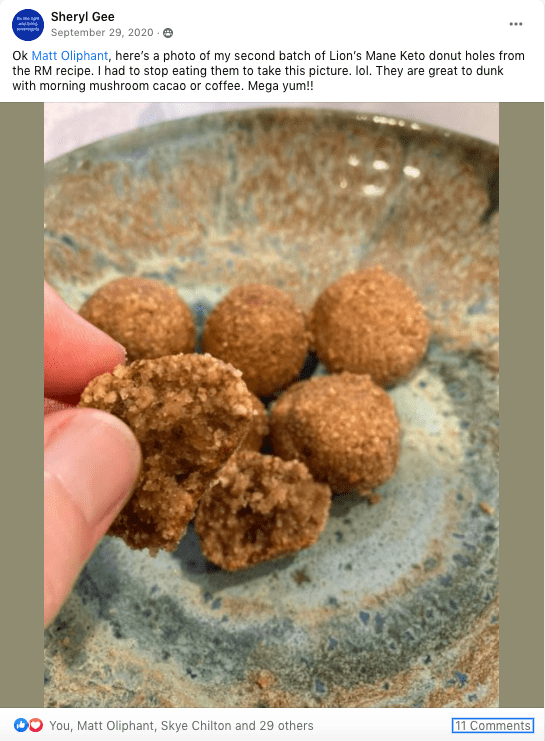
Integrative nutritional health coach, Edith Agoston, developed this take on the classic bulletproof coffee recipe for the Real Mushrooms audience. This butter coffee recipe amps it up a notch by adding some extra special ingredients like cacao butter, collagen, maca root, and Lion’s Mane powder extract. The final result is this gorgeous, frothy cup of coffee that is sure to excite all the sights and senses.
INGREDIENTS
DIRECTIONS
Add everything to a blender and blend for roughly 10-20 seconds. It will come out nice and frothy as a result!
Find the original post here. You can use Lion's Mane powder extract in any of our 11 mushroom coffee recipes.
Once you’ve tried out any (or all!) of these Lion’s Mane recipes, please be sure to share the results and your impressions (and any of your tweaks) with our Facebook Group or Instagram.
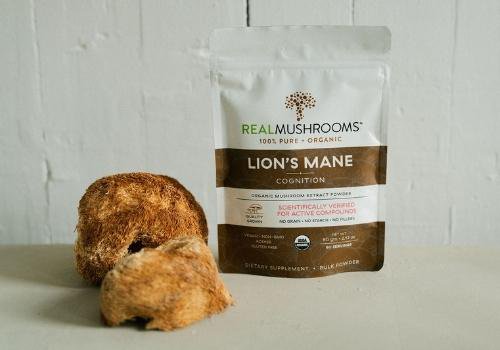 References
ReferencesOnce you’ve learned about the multiple health advantages of Lion’s Mane mushroom supplements, it’s time to weed through the buying options. It can be difficult to know what the best Lion’s Mane supplement is for your money. There are a growing number of brand options given that functional mushroom supplements have gone mainstream. While the dietary supplement industry is regulated, mislabelling and confusing marketing is still prevalent. It is important to be aware of what to look for when trying to find a supplement of quality. That quality will help determine whether you will get the health benefits you are looking for.
This guide will help you understand what to look for when shopping for the best Lion’s Mane supplement.
For a quick primer, skip to our Take-Away Buying Guide.
There is a lot of debate about what is the best part of this fungus to use for the specific cognitive benefits that Lion’s Mane is known for: the mushroom (fruiting body) or mycelium (the root-like fungal filaments that the mushroom grows from).
Two compounds are the area of focus of this debate: hericenones, which are found in the mushroom, and erinacines, which are found in the mycelium.
Both hericenones and erinacies have demonstrated neuronal health supporting properties in scientific studies (1). Therefore, what product should you choose: a mushroom supplement (for the hericenones) or a mycelium-based supplement (for the erinacines)?
There are two problems with opting for mycelium-based Lion’s Mane supplements:
1. Supplements made from mycelium include the grain it is grown on. This effectively dilutes the product and its medicinal compounds. Erinacines only occur in very small amounts in pure mycelium (~0.01%). The grain the mycelium is grown on further diminishes this concentration.
2. Lion’s Mane mycelium research is based on pure mycelium via liquid fermentation. Liquid fermented mycelium is very different than the myceliated grain commonly found in Lion’s Mane supplements.
Currently, most of the clinical data on Lion’s Mane is based on research using the mushroom (fruiting body) (1).
For these reasons, Real Mushrooms only uses the mushroom for our Lion’s Mane Supplements, which the existing body of clinical data supports.
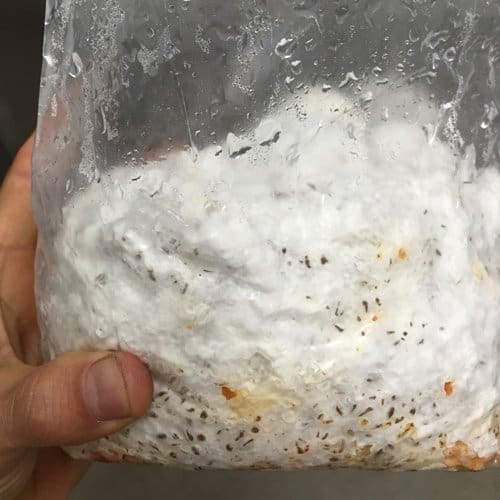
Much of the research on the neurotropic and neuroprotective properties of Lion’s Mane focuses on the compounds hericenones and erinacines. However, there is no reliable lab that can test for these compounds.
Any claim that a product makes about these compounds is speculative at best.
Many Chinese suppliers are selling products with a guarantee of specific amounts of both compounds. Misleadingly, these suppliers are using UV testing methods, which are very unreliable and inaccurate and can end up quantifying the wrong compounds. These so-called compound-specific guarantees can give brands reselling these ingredients a false sense of quality and reliability.
Real Mushrooms has spent years and many thousands of dollars trying to quantify these compounds. We continue to push on and look for ways to quantify these compounds.
Once we can quantify these compounds, we can begin to optimize our products for them.
Until more reliable and repeatable testing methods become available, Real Mushrooms continues to focus on the clinical data that support the use of the mushroom in its entirety.
Many brands will add in a variety of starch, fillers, colorings, unnecessary additives, and other ingredients to their mushroom supplements. These additions provide no health benefits. Worse yet, they are an indication of a low percentage of the actual Lion’s Mane extract found in the product. This results in a lower concentration of beta-glucans (medicinal compounds) in the supplement, which indicates a lower therapeutic potency.
Product labels can be misleading. Many popular supplement brands hide the use of myceliated grain and other fillers. To get the most potent and high-value functional fungi supplement, look to the product label for the specific beta-glucan content. If the beta-glucan content is not indicated on the label, it is unlikely that the product has sufficient levels.
Real Mushrooms always includes the percentage of beta-glucans on its product labels. The beta-glucan in Real Mushrooms’ Lion’s Mane supplement is greater than 25% which is one of the highest concentrations on the market.
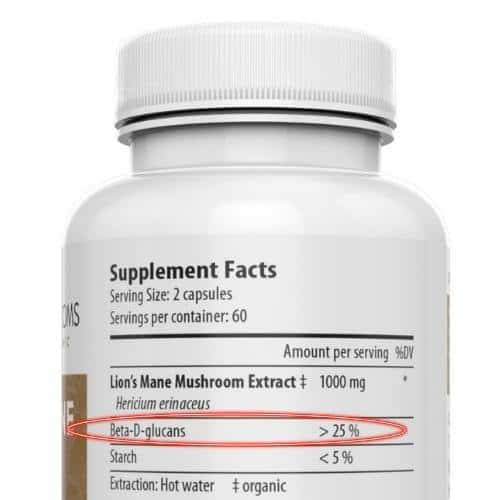
Beta-glucans are the primary compound in mushrooms responsible for its immune-supporting functions and other medicinal properties.
Beta-glucans are commonly regarded as being Biological Response Modifiers (BRMs) (2). BRMs work by supporting the immune system to turn up or turn down. For example, BRMs can stimulate an increased immune response that in turn enables a more effective reaction for fighting off infections. In contrast, they can also turn down an overactive immune response via anti-inflammatory cytokine modulation.
To learn more about the other health benefits of beta-glucans, read our article A Look at the Powerful Benefits of Beta-D-Glucan.
When considering a Lion’s Mane supplement, it is important to make sure you can getting a high quality product that is free of possible contaminants.
A couple questions to ask about the mushroom supplement:
Organically grown mushrooms mean that these mushrooms have been grown naturally without the use of any types of herbicides, fungicides or pesticides.
All Real Mushrooms products are tested multiple times during the production process at accredited 3rd party labs to ensure our products are free from agricultural chemicals.
One important note about capsule products is that these products cannot be USDA certified organic because the capsules themselves are not certified organic. However, you can ensure that the mushroom powder within the capsule is certified organic by checking the Supplement Facts panel on the label.
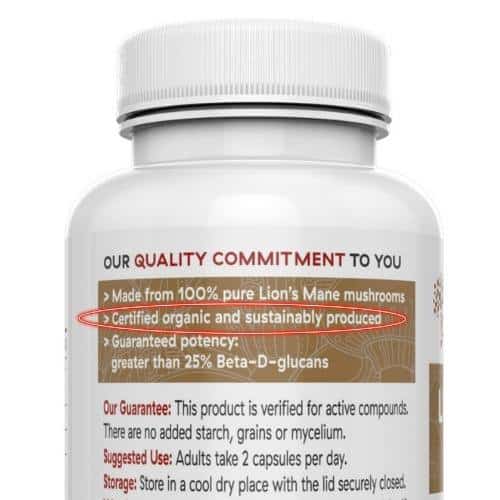
Levels of heavy metals are also an important factor as mushrooms are bioaccumulators and absorb minerals and heavy metals from their growth substrates. Real Mushrooms screens for heavy metals at multiple steps during production to guarantee that we greatly exceed the heavy metals standards set by the FDA and Health Canada.

Knowledge about the ingredients that you are incorporating into your diet is important. This rings especially true when it comes to functional mushrooms and their quality. A low-quality mushroom supplement won’t allow you to experience all the potential benefits, and your health is not something to gamble with.
The first sign of a high-quality functional mushroom product is that it is extracted from the mushroom (fruiting body) using the appropriate method. There are three methods of extraction in use with functional mushrooms:
There is some debate over which of these methods results in the highest-quality extraction. Research shows that not every method is effective for every mushroom and that some may even be detrimental as they remove medicinal constituents in the process. With that in mind, it’s important that any supplement producer understand which extraction method will provide the maximum benefit and highest efficacy in the product.
Real Mushroom’s decades of expertise and experience allow us to tailor the extraction method we use to each individual type of mushroom to attain peak potency. Our Lion’s Mane products are extracted using the hot water method and use the entire mushroom. This way we can guarantee all the medical properties and benefits are transferred to the extract, delivering a product of the highest quality that you can feel confident in.
Real Mushrooms’ supplements are trusted by leading health practitioners and naturopathic doctors around North America because of their purity and potency. In the words of one of our customers who is a naturopathic doctor, here is why our Lion’s Mane supplements are used and recommended by medical professionals:
“I am a licensed naturopathic physician and acupuncturist, and I am so grateful to be able to recommend Real Mushrooms formulas to patients. They are of utmost quality--grown and processed properly in order to be truly rich in beneficial mushroom-derived medicinal compounds. Personally, I am using your Lion's Mane capsules as part of a neurological support program... Your mushroom extracts are the only ones I use and recommend, because they are the ones I trust most for potency and purity. Thank you for your dedication and integrity!” - Dr. Mark Bricca
Incorporating a Lion’s Mane supplement into your daily regimen can be a great resource for your health. And lucky for you, it’s never been easier to get your hands on quality medicinal mushroom supplements.
However, there are many lower quality products on the market now that functional mushroom supplements have become mainstream.
Remember these tips when you are evaluating any potential mushroom supplement, to make sure you are getting a safe, high-purity, and high-potency product:
If you want a Lion’s Mane product that is trusted by consumers and health professional alike, we invite you to try the Real Mushrooms Lion’s Mane powder or capsules.

1. Sabaratnam, V., Kah-Hui, W., Naidu, M., & Rosie David, P. (2013). Neuronal health - can culinary and medicinal mushrooms help?. Journal of traditional and complementary medicine, 3(1), 62–68. https://doi.org/10.4103/2225-4110.106549
2. Alberts, B., Johnson, A., Lewis, J., Raff, M., Roberts, K. and Walter, P. (2020) Innate Immunity. <https://www.ncbi.nlm.nih.gov/books/NBK26846/>